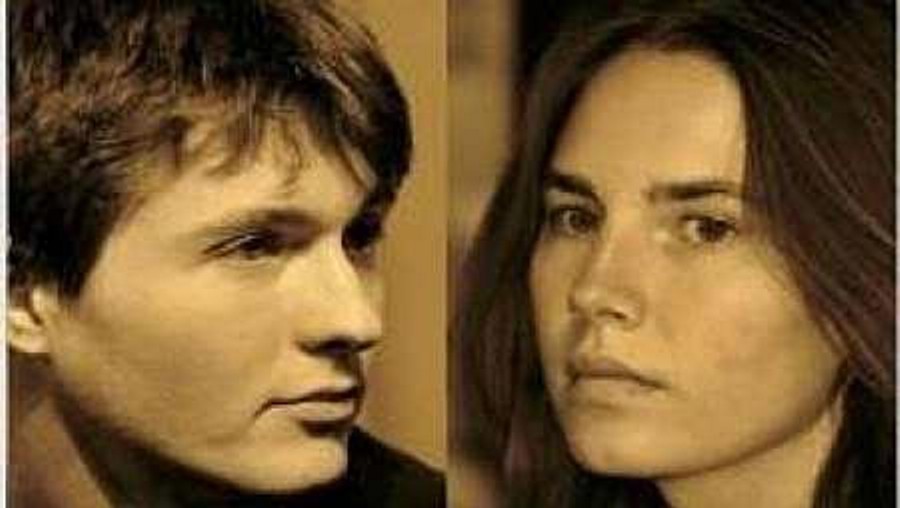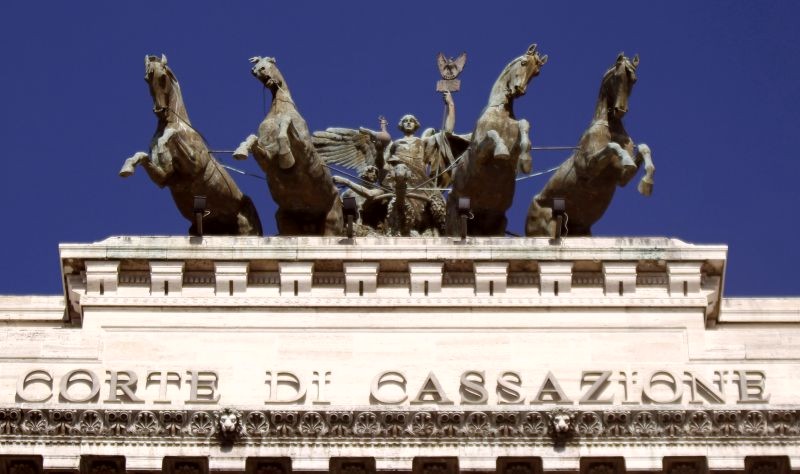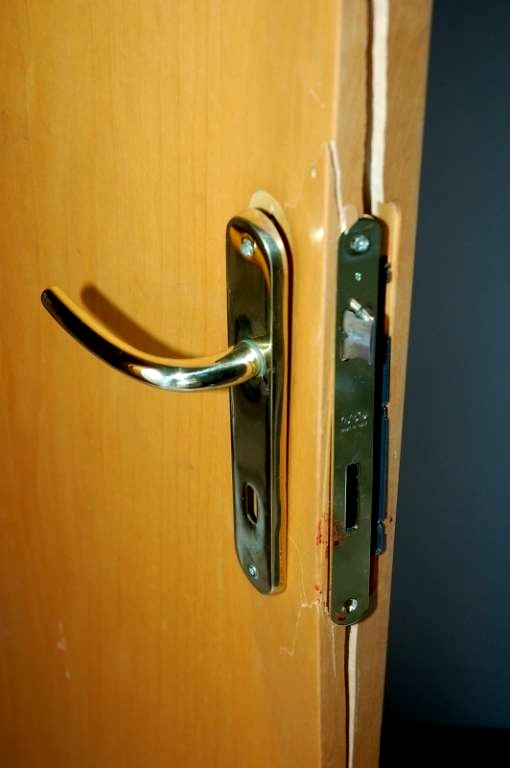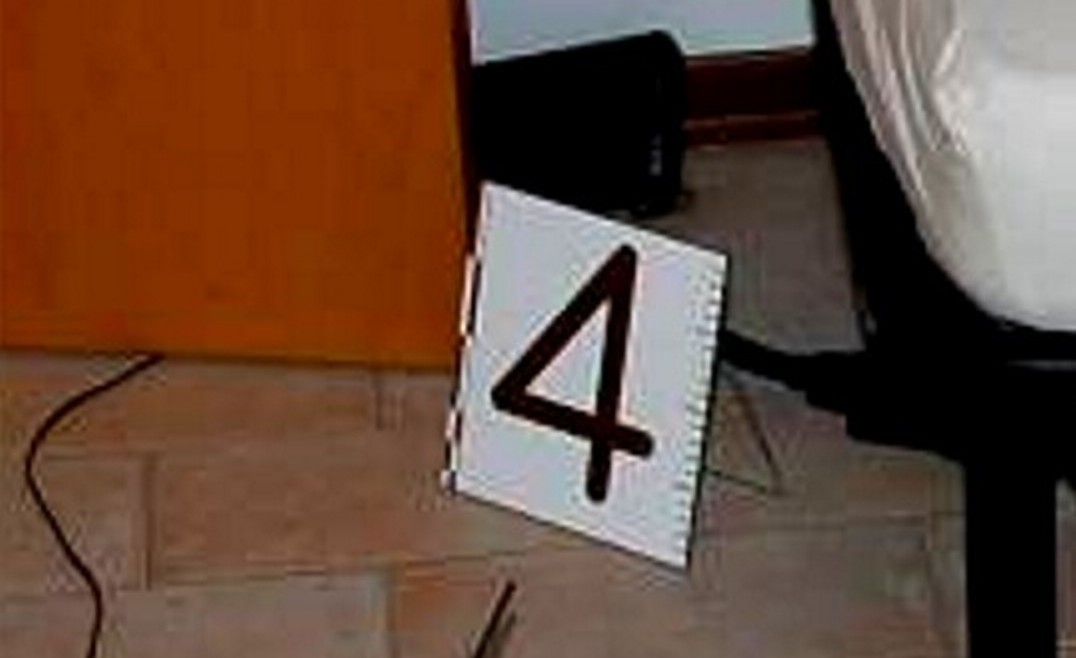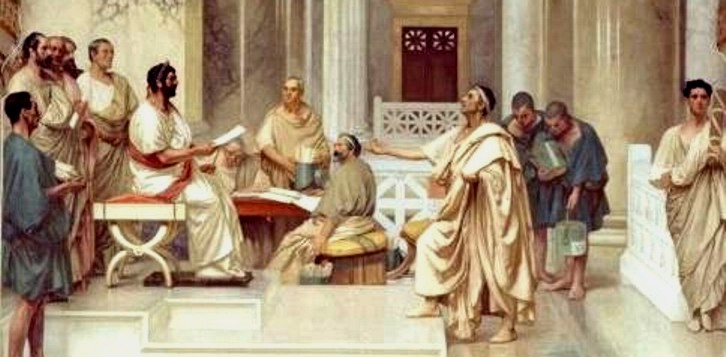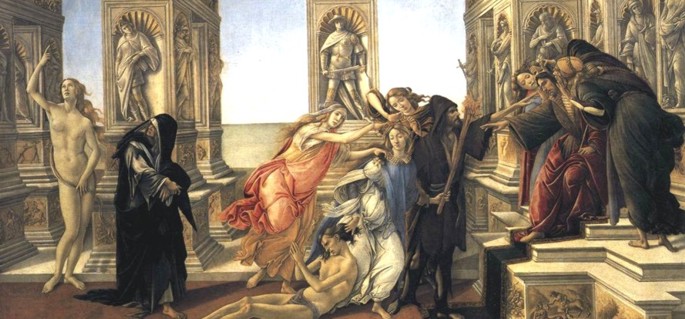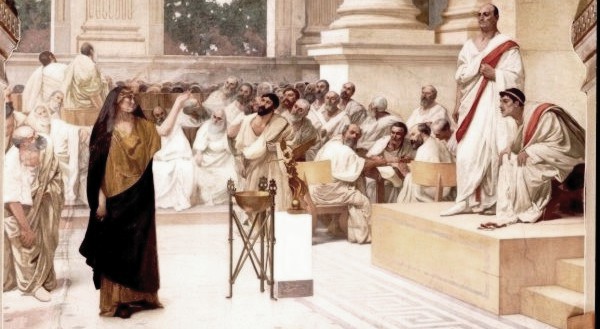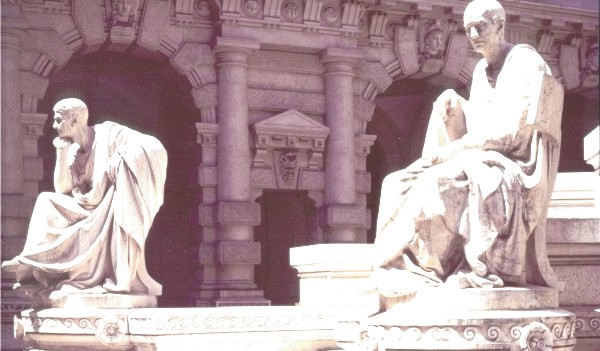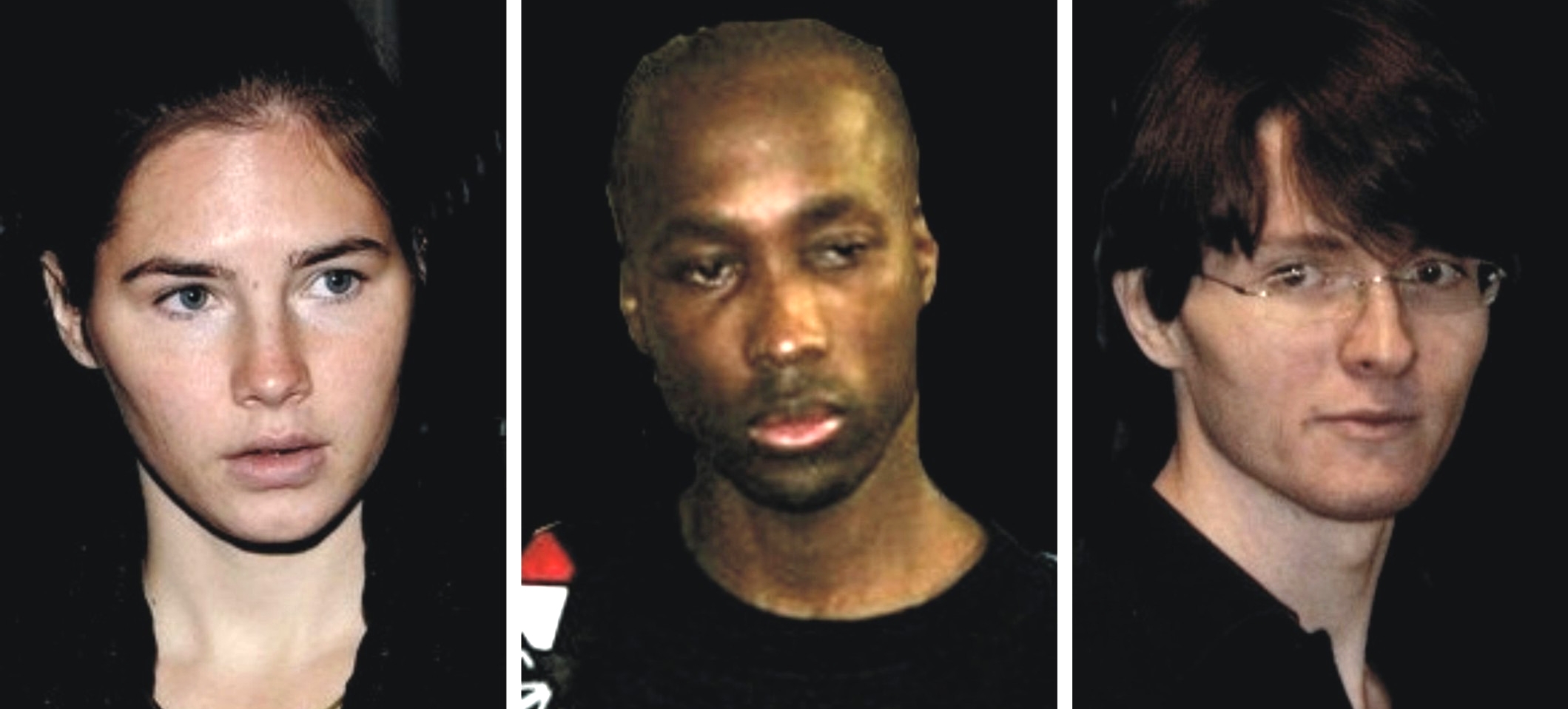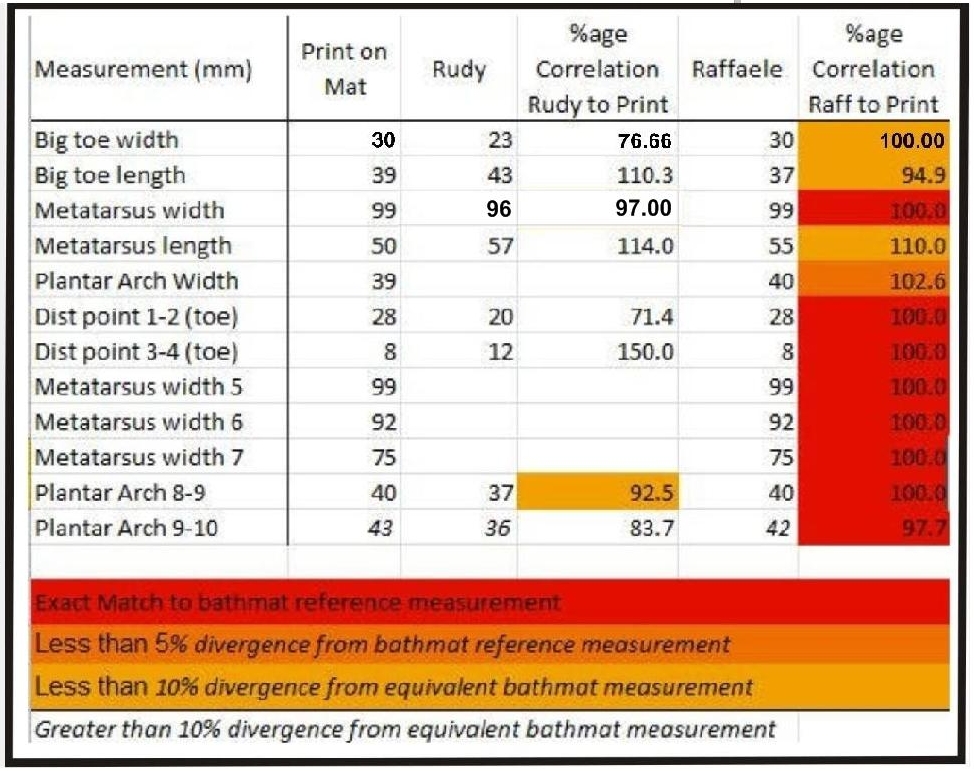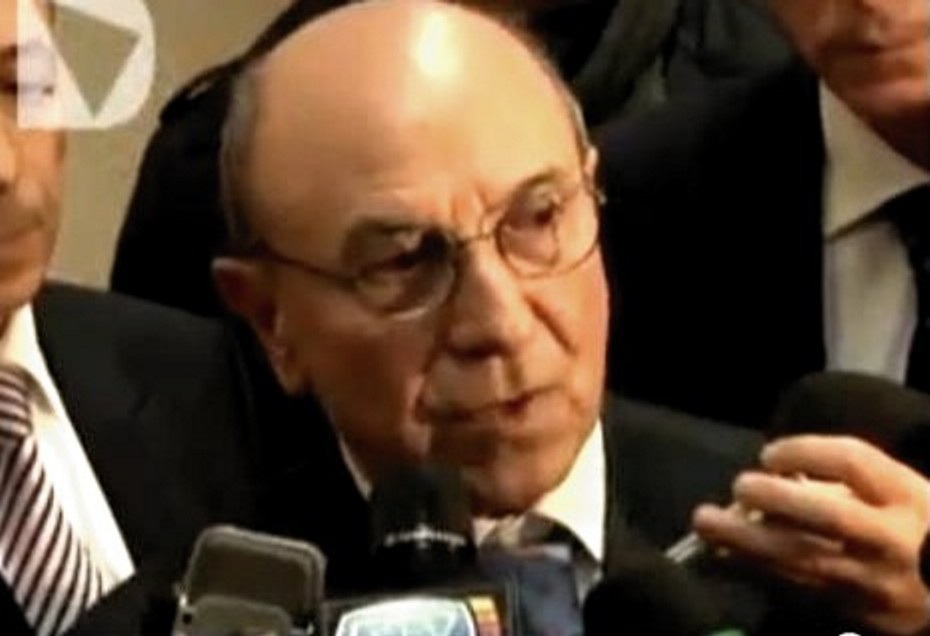
Category: 3 No evidence hoax
Tuesday, October 08, 2013
Questions For Knox and Sollecito: Why Claim Rudy Guede Did It Alone When So Much Proof Against?
Posted by Marcello
1. Problems Of Your “Guede did it alone” Mantra
Your attempts to frame Guede for the entire attack sound racist, and they fly in the face of a multitude of hard facts.
Why are you and your more untethered supporters arguing to the media that Rudy Guede alone attacked Meredith (he could not have), that he was a drifter (he wasnt), a burglar (he wasnt), and drug dealer (he wasnt), and that his DNA traces are “all over Meredith’s room” (they werent)?
There are surprisingly few DNA traces of Guede in there, and outside Meredith’s door there is only evidence of (1) his prior use of the south bathroom, and (2) his shoeprints headed straight for the front door.
There is zero evidence that Rudy Guede was ever in the shared bathroom (the one with Sollectio’s bloody footprint on the bathmat) and zero evidence he was in Filomena’s room (the one with the broken window and the mixed DNA of Meredith and Knox).
2. Evidence Against You Is Far, Far Stronger
Explain if you can about Sollecito’s bloody footprint. Explain if you can about the evidence of cleanup. Explain this and this about your multiple contradictory alibis.
Explain if you can why YOUR own witnesses Alessi and Aviello were such disasters for your side in court. Explain your cell phone actions (or non-actions) and the timing and content of your phone calls, and your computer actions (or non actions).
Explain why in Sollecito’s book he claims he sent several emails throughout the night; but there zero records of such emails with his email provider. Explain why both Sollecito and Knox framed Dr Mignini.
There are three compelling reasons above all why the Massei court and the Supreme Court will remain totally unbending on the point that Guede did NOT attack Meredith alone, and that it had to be a pack attack on Meredith.
- One is the full day of closed court testimony at trial by crime-scene experts from Rome who accounted for every point of evidence in Meredith’s room with a depiction of a 15 minute pack attack involving three people. This seriously upset the jury and your own defense was left essentially speechless.
- One is the prosecution’s video shown in closed court during Summations of the recreation of the attack on Meredith, which accounted for every point of evidence with a 15 minute pack attack involving three people. This seriously upset the jury and your own defense was left essentially speechless .
- One is that the entry of an attacker via Filomena’s room is so absolutely unbelievable. Your own defense always knew this, and barely tried to make that sale (hence the witnesses Alessi and Aviello).
There are seven other routes for a burglar to enter the house, all of them faster and quieter and five of them darker. You can see five in these images below: two via the east windows, three up onto the balcony and into the house via the louvre door or the kitchen window.
All seven routes would be obvious to any burglar, long before he walked all the way around the base of the house to beneath Filomena’s window (which he did several times in your scenario).
3. The Numerous Questions From Which You Hide
On or after 6 November you have both promised to appear in the appeal court in Florence. You are apparently too nervous to face cross-examination under oath, but you have said you intend to try to explain things.
- 1) Rudy Guede had been to the apartment at least twice already on prior occasions and knew the boys who lived in the lower story. Why did Guede choose to NOT break-in to the lower story where he knew (or could ascertain) that all four boys were away on holiday, and therefore could break-in and rummage with some certainty of not getting caught?
2) Why did Guede choose to break-in to the upper story of the villa mid-evening, when he surely knew Knox and Kercher would be staying at the villa for the holidays and could have been there or returned at any time to “catch him in-the-act”?
3) Surely Guede would have verified that no one was present by circling the cottage and checking if any lights were on in the windows? But Guede “missed” the really easy way in: the balcony in the dark at the rear, used in 2 burglaries in 2009.
4) If Guede did circle the cottage to make sure no one was there before attempting the break-in, why would he then choose the most visible and more difficult path of entry through a second story window, as opposed to the more hidden and easier path of break-in at the back of the villa, which he would have noticed while circling the villa?
5) Why would Guede choose to break-in through a second story window that was highly exposed to the headlights of passing cars on the street as well as exposed to night lighting from the carpark?
6) Ms. Romanelli testified that she had nearly closed the exterior shutters. Assuming her memory is correct, there is no way a burglar could easily verify if the windows were latched and if the inner scuri were latched to the window panes, which would make access to the window latch impractical unless one was armed with a core drill or an ax. Why would Guede, who was certainly familiar with such windows, choose to attempt the break-in through a window that he could not easily verify would allow him quick access?
7) Assuming the shutters were closed, Guede would have to climb up the wall and open the shutters before smashing the window with the rock. The night of the murder, the grass was wet from rain the previous day. Why was there no evidence of disturbed grass or mud on the walls?
8) Guede had Nike sneakers, not rock climbing shoes. How did he manage the climb up the wall with that type of footwear?
9) If the shutters were closed, or somewhat closed, how did Guede manage to lift himself up to the sill with only an inch of sill available to grab onto?
10) Assuming Guede opened the shutters, how did Guede verify if the inner scuri where not latched to the window panes, which would prevent access to the window latch? There was no light inside Ms. Romanelli’s room to reveal that the scuri were ajar.
11) Assuming Guede managed to check that the inner scuro behind the right-hand window was not latched, how did he manage to break the glass with a 9 lb rock with one hand while hanging on to the sill with the other?
12) Assuming Guede managed check that the right-hand inner scuro was not latched, how did he break the glass with the rock without having glass shards fly into his face?
13) If Guede climbed down to the lob the 9 lb rock at the window from 3 meters below, how would he do so to avoid glass shards raining down on him?
14) If Guede climbed down to the lob the rock at the window from below, why would he choose a 9 lb 20 cm wide rock to lob up to a window 3 meters above him, with little chance of striking the window in the correct fashion?
15) If Guede climbed down again and climbed back up to the carpark (up a steep slope with slippery wet grass and weeds) to lob the 9 lb 20 cm wide rock from the car park, why is there no evidence of this second climb down on the walls?
16) Why did Guede choose a 9 lb 20 cm wide rock to throw from the car park, given that a large, heavy rock would be difficult to lob with any precision? Especially considering that the width of the glass in the window pane is only 28 cm wide, surely anyone, experienced or not, would have chosen a smaller, lighter rock to throw with greater precision.
17) If Guede lobbed a 9 lb 20 cm rock from the car park, such a lob would require some velocity and therefore force. Guede would have been roughly 11-12 feet away from the window, in order for the lob to clear the wood railing at the carpark. If the rock was thrown with some velocity, why is the upper 1/2 of the glass in the window pane intact, without any fracture cracks at all?
18) If Guede lobbed a 9 lb 20 cm rock from the car park, such a lob would require some velocity and therefore force. Why is there so little damage to the scuro the rock hit, so little damage to the terrazzo flooring impacted by the rock, and so little damage to the rock itself, which surely would have fractured more on impact with a hard terrazzo floor?
19) Why was there no evidence of glass shards found in the grass below the window?
20) If Guede climbed the wall to open the shutters, climbed down and up to the car park to throw the rock, then climbed back down and up again to the window, how does he manage to hoist himself onto the sill without cutting himself on the glass that was found on the sill?
21) If Guede climbed the wall to open the shutters, hoisted himself onto the sill, tapped the glass with a 9 lb rock to lightly break the glass in a manner more consistent with how the window was broken, why did he throw the rock into the room, rather than let it fall into the grass below?
22) Why was no dirt, grass, muddy shoeprints or similar trace evidence found on the window sill?
23) Why was no dirt, grass, muddy shoeprints or similar trace evidence found in Romanelli’s room?
24) If Guede climbed the wall to open the shutters, climbed down and up to the car park to throw the rock, then climbed back down and up again to the window again, hoisted himself onto the sill without cutting himself on the glass that was found on the sill, unlatched the window and stepped inside Filomena’s room, how did he manage to get glass on top of Romanelli’s clothing that was found under the window sill?
25) Why would Guede, who would have spent a good 10 minutes trying to break and enter with the climbing up and down from the carpark, waste valuable time throwing clothes from the closet? Why not simply open the closet doors and rifle through the clothes without creating more of mess?
26) Why did he disregard Romanelli’s laptop, which was in plain view?
27) Why did Guede check the closet before checking the drawers of the nightstand, where surely more valuable objects like jewelry would be found?
28) Why were none of the other rooms disturbed during the break-in?
29) Assuming Ms. Kercher arrived to the cottage after Guede’s break-in, presumably when Guede was in the bathroom, why did she not notice the break-in, call the police and run out of the cottage?
30) Assuming Guede was in the bathroom when Ms. Kercher returned, why go to the extent of attacking Ms. Kercher in her room rather than try to sneak out the front door, or through the window he had just broken, to avoid if not identification, at least more serious criminal charges?
31) Assuming Ms. Kercher was at the cottage while Guede broke-in, why did she not call the police the moment she heard the rock crash through the glass, loudly thud to the terrazzo floor and investigate what was happening in Romanelli’s room while Guede was climbing back down from the car park and climbing back up to the window?
32) Assuming Ms. Kercher was at the cottage while Guede broke-in, Guede could have been on the sill already because he had tapped the glass with the 9 lb rock to break it. Therefore perhaps Guede was already partially inside Romanelli’s room when he was discovered by Ms. Kercher. In this case Guede follows Ms. Kercher to her room in an attempt to dissuade her from calling the police and the assault ensues. But then, if this scenario is correct, when does Guede have time to rifle through Romanelli’s clothing and effects?
33) Why is there a luminol revealed footprint in Romanelli’s room that has mixed traces of Knox’s and Kercher’s DNA ?
34) Why does this footprint not match Guede’s foot size?
35) If multiple attackers were required to restain Ms. Kercher, holding her limbs while brandishing two knives and committing sexual violence, then who else was with Guede and why no traces of this 4th (or more) person(s) were found, either in shoeprints, footprints, fingerprints, DNA or otherwise?
36) If Guede and others were involved in the assault, why has Guede not acknolwedged them, and instead consistently hinted that, and finally admitting that Sollecito and Knox were with him during the assault?
37) If Guede and others were involved in the assault, why do the other shoeprints, footprints, DNA traces and fingerprints all point to Knox and Sollecito being present during the assault, in one way or another?
4. Italy Is Not Buying The Racist Mantra
If your racist mantra remains “the black guy did it alone” and “Italians are corrupt and stupid” you need to PROVE that. If you cannot answer all of these questions above, this will deservedly cook you.
You could be facing 30 years with the “mitigating factors” canceled and the new penalties you will incur for your dishonest books and PR campaigns.
[Five easier ways in: 3 via balcony (note two drainpipes, window grid below), 2 via side windows]
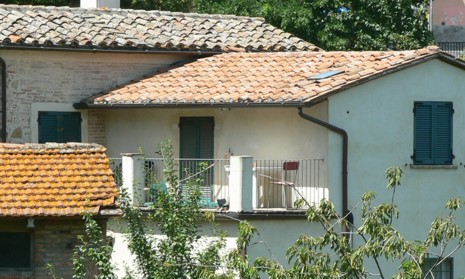
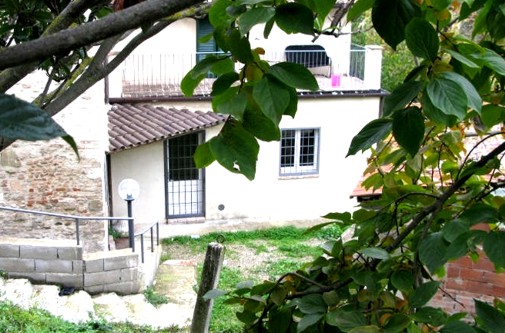
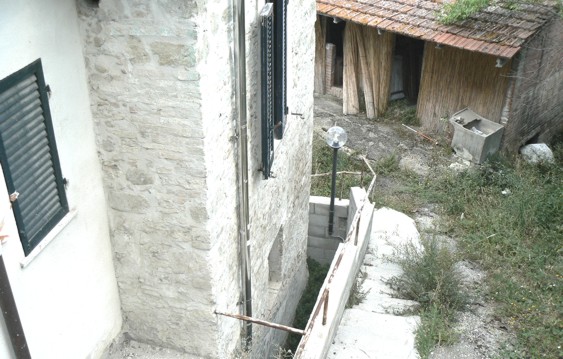
Monday, September 09, 2013
In English, The Chieffi Supreme Court Rationale For Hellmann Annullment & Florence Repeat Appeal
Posted by Our Main Posters
1. What Happened Today
This immensely intriguing report dated 25 March 2013 has now been put into English.
The translators are the PMF posters and Italian speakers Catnip, Clander, Earthling, Jools, Popper, Skeptical Bystander, The 411, Thoughtful, Tiziano, TomM, and Yummi,
These are members of the same team that has already done so much to level the playing field which the defense forces have tried so hard to tilt by way of the fact that Italy speaks a different language.
2. What We Already Said
On 23 June in his summary for English speakers our main poster Yummi started off as follows:
On June 18. 2013 the Supreme Court of Cassazione issued the official rationale for the sentence of annulment of the Hellmann-Zanetti verdict.
That verdict acquitted Amanda Knox and Raffaele Sollecito on the charge of murder and sexual violence, while finding Knox guilty of the crime of calunnia (obstruction of justice by maliciously placing false accusation against a person you knew was innocent)....
The 74-page motivation report states clearly that they “˜accept the points of the recourse’ from both the Prosecution and the Kercher parties, while they reject the Knox defense recourse.
While you will realize it yourself in reading it, I can say in advance that what the Supreme Court points out in the appeal verdict is a pattern of manifest violation of an unprecedented gravity. All those I know in the law professions have never seen, throughout their professional lives, a Cassazione bashing portraying such a concentration of flaws in one verdict.
Mostly written by Judge M. S Caprioglio (possibly including parts by Judge Severo Chieffi) the document features a sophisticated Italian language and a formal style.
Below at front: some of the judges of the Supreme Court’s elite First Section with Dr Caprioglio at right]
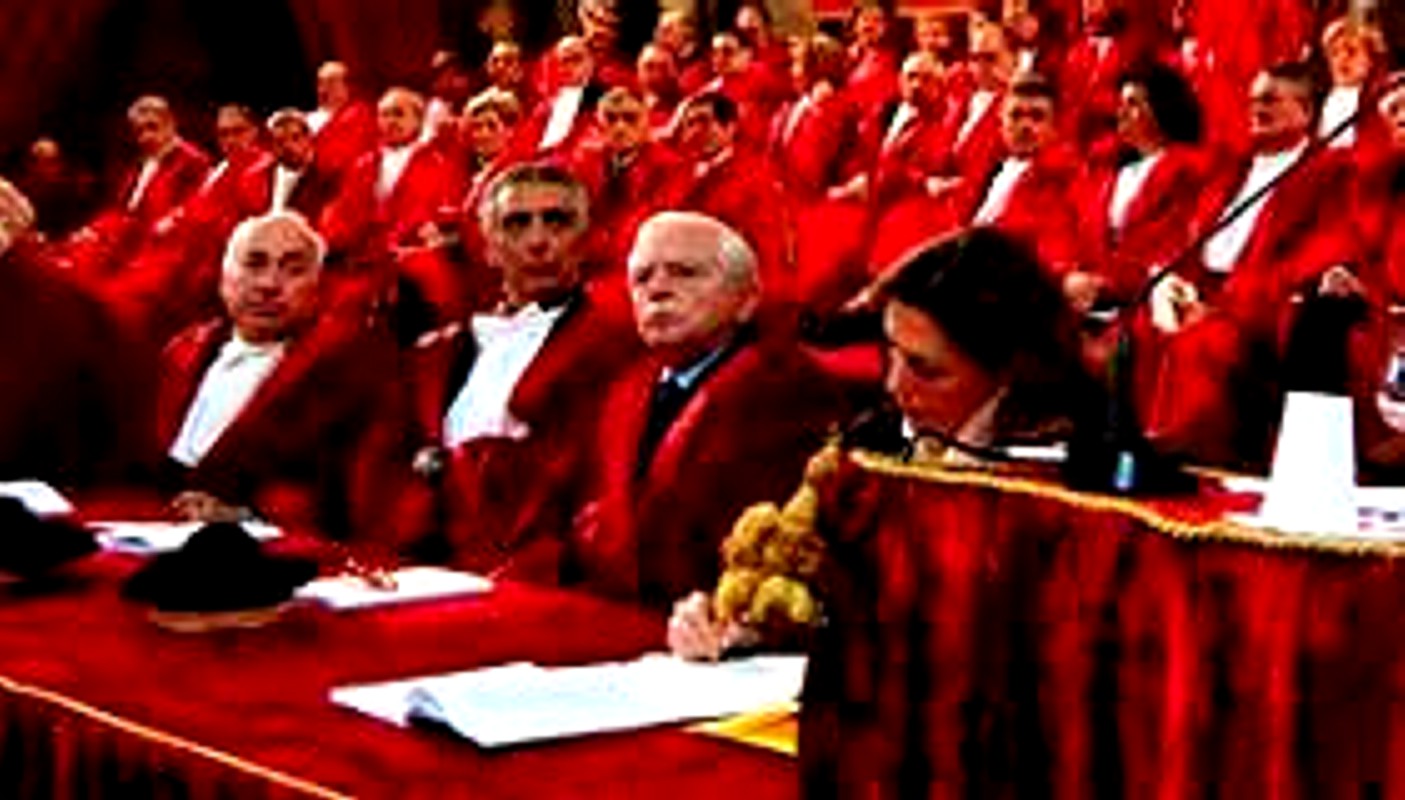
Wednesday, July 24, 2013
How The Clean-Up And The Locked Door Contribute To The Very Strong Case For Guilt
Posted by James Raper
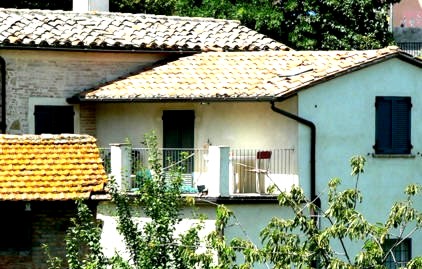
On the 30th September the appeals of Amanda Knox and Raffele Sollecito against the convictions they received at the first instance trial will resume, this time in Florence.
This follows the annulment by the Supreme Court of the acquittal verdicts rendered by the Appeal Court presided over by Judge Pratillo Hellmann. There is one conviction not under appeal. This is Knox’s conviction for calunnia, which is now definite.
They are therefore both currently convicted of murder and sexual assault, and a number of lesser charges, amongst which there is the simulation of a burglary “to ensure impunity for themselves from the felonies of murder and sexual assault, attempting to attribute the responsibility for them to persons unknown who penetrated the apartment to this end”.
There is one activity, for which there is evidence, with which they were not charged (perhaps either because it was redundant or not a criminal offence) though this was likewise to ensure impunity for themselves.
This is the partial clean up at the cottage and it is this with which I intend to deal. I want to highlight salient observations which have been under discussion here and elsewhere and some of which may be well known to readers, but perhaps some not, or have been forgotten about. Once again, in many cases, I am merely a conduit for the observations of others, not least the first instance trial judge Giancarlo Massei.
So let”˜s consider the observations and in doing so we can also throw some more light on the lone wolf theory.
1. Take a look at the bloody footprint
This is, of course, the bloody footprint on the bathmat in the small bathroom right next to Meredith’s room.
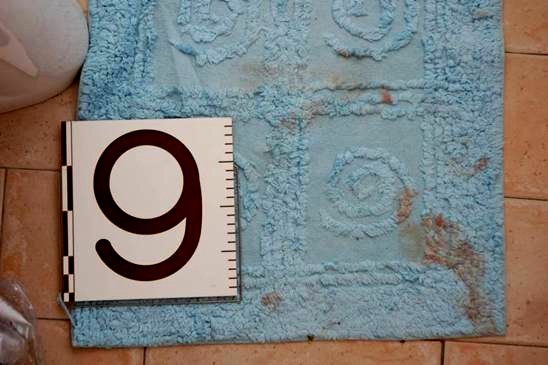
The heel of the right foot, if it had blood on it, is missing from where it should be on the tiled floor. It is difficult to imagine, given that the imprint of the foot on the mat is contiguous with the edge of the mat, that there was not at least some blood on the remainder of the foot such that there must have been at least some blood deposited on the floor.
Just as difficult to imagine that casual shuffling about on the bathmat would have removed the blood so as to render it “invisible” to the use of luminol.
Of equal relevance is that there were no connecting bloody footprints. Why not?
The defences have an improbable theory - that Guede, despite his homicidal rage, was smart enough to hop about on his left foot with a clean shoe on, and the other bare but covered in blood, and that having by this means entered the bathroom and washed his bloody right foot, disastrously leaving his (supposed) imprint there in the process, he then returned to Meredith’s bedroom inadvertently standing in blood with his left shoe and leaving with a trail of bloody left shoe prints - in which case the exercise of washing his foot was entirely in vain, on two counts, after all that careful hopping around.
Neither is it entirely clear why his right shoe came off in the first place.
It is far more probable that the inevitable bloody prints were deliberately and carefully removed. The reason for doing this was not just to conceal who would have made them (the print on the bathmat was, after all, left in situ) but, from a visual perspective, to conceal any blood that might be noticeable and alarming to anyone approaching Meredith’s room. Guede’s bloody shoeprints in the corridor were visible but only on close inspection.
2. Take a look at the bathroom door
Specifically the internal (hinge) side of the bathroom door. Take a look at this photograph.
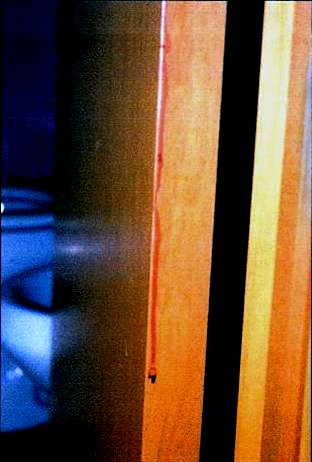
We see a long streak of dried blood. Clearly the blood has flowed some distance under the influence of gravity and we can see that it looks slightly diluted, with red corpuscles gathering towards the tip of the streak. A drip of that size does not appear from nowhere.
Indeed it is difficult to imagine how the blood got there unless it was part of a larger area of blood which most likely was on the face of the door and which was swiped to the right and over the edge of the face of the door. The cloth or towel used to do this was wet accounting for the slight dilution and length of the streak.
3. Take a look at Meredith’s door
It is interesting, is it not, that there is blood on the inside but not on the outside? The outside:
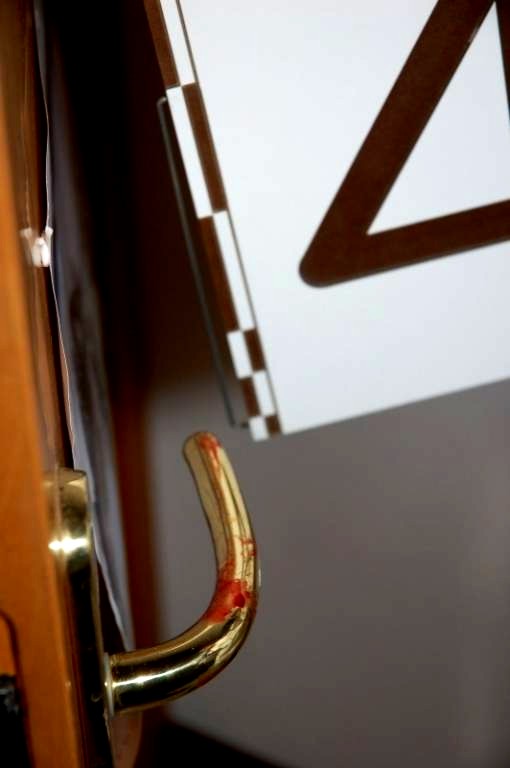
It is difficult to see how and why Guede touched the inside handle with a bloody hand (was it shut and if so, why?) and then closed the door to lock it without leaving a trace on the outside face of the door. Possibly he might have changed hands. The answer might also be that he visited the bathroom to wash his hand as well as his foot, save that none of his DNA was recovered from the spots and streaks of diluted blood in the washbasin, whereas Knox’s DNA was. All the more surprising given that Guede shed his DNA in Meredith’s room.
We see some blood on the edge of the door which again might be the remnant of a trace on the outside face.
4. Take a look at Amanda Knox’s lamp.
This was found inside Meredith’s room behind the door. Meredith also had a similar lamp which was resting on it’s base on the floor by her bedside table.
The presence and location of Knox’s lamp is obviously suspicious. Had Meredith borrowed Amanda’s lamp because her own was not working, then it would not have been in the position it was found but on or more likely knocked over and lying beside the bedside table since the violence appears to have been concentrated in that area of the room.
Had Meredith’s lamp been on the bedside table then likewise it too would most likely have been knocked over in her life and death struggle with her sole assailant (there are blood streaks on the wall just above) and it would not have ended up sitting upright on it’s base.
Both lamps were probably used to check the floor of Meredith’s room after the event and Knox’s lamp was probably sitting upright until it was knocked over by the door being forced open.
This is Meredith’s lamp by the bedside table.
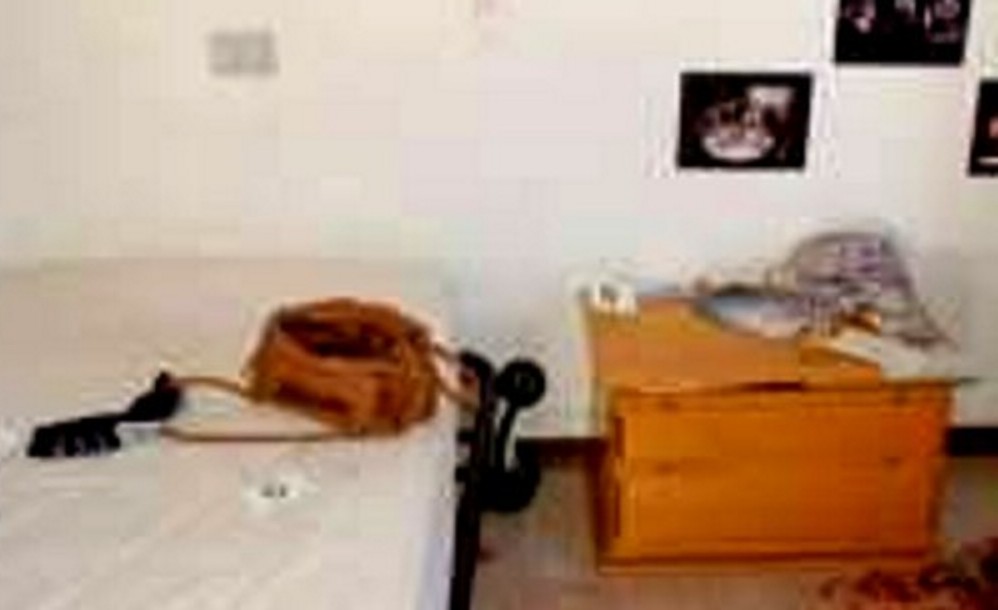
And this is Knox’s lamp by the foot of the bed.
5. Take a look at what luminol revealed
We can state with confidence that luminol (extremely sensitive to and typically used to identify blood that has been wiped or washed away) discovered :-
(a) three bare footprint attributable to Knox, one in her bedroom and two in the corridor, and
(b) two instances of the mixed DNA of Meredith and Knox, one in Filomena’s bedroom and one in the corridor.
(c) a footprint attributed to Sollecito in the corridor.
I have covered a number of elements strongly suggesting that there was at least a partial clean up, not of “invisible DNA” as the Groupies like to mock, but of what would have probably in some cases have been noticeable deposits of blood that would have attracted the eye of anyone entering the cottage and which would certainly have alarmed the observer as being difficult to explain.
Spots of and footprints in blood, not just in the bathroom but outside it, a locked bedroom door with blood on it, and a bathroom door with blood on it’s face.
We can include Knox as one such observer given her e-mail account of having allegedly stopped by the cottage to have a shower and collect some clothing before the discovery of the body. Such physical evidence - had it not been removed - would not have sat easy with that account, however dizzy and naïve Knox presents herself. One can envisage Knox thinking “sorted” - that her story would now work perfectly.
Even so, there were elements that were overlooked, such as Knox’s blood on the washbasin faucet and blood generally in the small bathroom, but a door can be closed and at least these were elements amenable to some form of explanation from her perspective, whether or not convincing, as occurred in the e-mail.
Incidentally in addition to the mixed traces in the small bathroom, Meredith’s blood was found on the light switch and a cotton bud box. I have a hard time imagining what Guede would have wanted with the cotton bud box, less so Amanda given her blood on the faucet, ear piercings and a scratch on her throat. Knox, when asked during her trial, could not recall having switched on the light during her alleged visit to the cottage.
6. Take a look at the items on Knox’s bed
Massei concluded that it was likely that it was Knox who carried out the clean up, which if correct might explain why it was not central to her thinking to dispose of the bathmat with Sollecito’s bloody footprint on it!
Knox was seen by Quintavalle at his store at 7.45 am on the 2nd November, thereby destroying her alibi. He described her as pale faced, exhausted looking, with pale blue eyes. He also added, and he would not have known this from photographs in the newspapers, that she was wearing blue jeans, a grey coat and a scarf, with a hat or cap of some sort.
We can see from the crime scene picture of Knox’s bedroom below, that such items (minus hat or cap) appear to be lying on her bed.
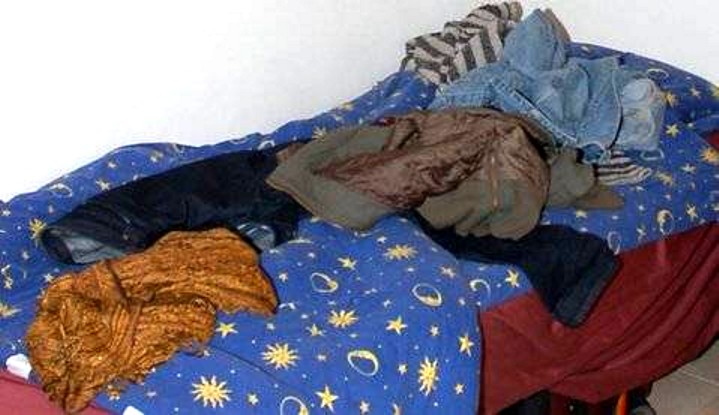
Sollecito did not accompany Knox to the store but this would be because he was known to Quintavalle whereas he was unfamiliar with her. He may however have accompanied Knox to the cottage and/or have acted as look out for her when she was there.
7. Some conclusions
I have included “The locked room” in the title because of a poster’s observation regarding Guede’s bloody left shoeprints exiting Meredith’s room. There is the simple observation that these footprints are going one way only and not towards the small bathroom. But they do not even turn to face Meredith’s door, and again hard to imagine that this could be so if it was Guede who locked her door!
We can rule out Guede as having been involved in any aspect of the clean up precisely because of that trail of footprints and other evidence of his presence left behind.
Now that the travesty of the Hellmann acquittals has been truly exposed Knox and Sollecito face an impossible uphill task.
The clean up and the locked door are just two of many elements in this case which combine together and corroborate each other in a manner that enables us to see the truth beyond a reasonable doubt.
Sunday, June 23, 2013
A Summary Of The Cassazione Ruling On Annulment Of The Knox-Sollecito Appeal
Posted by Machiavelli

[Above and below: justice-themed artwork in Cassazione; motifs are used all over the world]
1. Introduction
On June 18, 2013 the Supreme Court of Cassazione issued the official rationale for the sentence of annulment of the Hellmann-Zanetti verdict.
That verdict acquitted Amanda Knox and Raffaele Sollecito on the charge of murder and sexual violence, while finding Knox guilty of the crime of calunnia (obstruction of justice by maliciously placing false accusation against a person you know is innocent).
Previously I posted here a summary of the recourse to the Cassazione by the Umbria Prosecutor-General Dr. Galati and Prosecutor Dr. Costagliola which demanded an annulment of the appeal verdict. I also posted here a first summary report, from the March 25-26 Supreme Court hearing, when the Hellmann verdict was annulled and thus prosecution recourse was won.
The 74-page motivation report states clearly that Cassazione “accept the points of the recourse” from both the Prosecution and the Kercher parties, while they reject the Knox defense recourse.
While you will realize it yourself in reading it, I can say in advance that what the Supreme Court points out in the appeal verdict is a pattern of manifest violation of an unprecedented gravity. All those I know in the law professions have never seen, throughout their professional lives, a Cassazione bashing portraying such a concentration of flaws in one verdict.
Mostly written by Judge M. S Caprioglio (possibly including parts by Judge Severo Chieffi) the document features a sophisticated Italian language and a formal style.
The first half of the report is a summary of judicial events and arguments made by the parties through the previous instances. The second part basically dismantles all the points of reasoning of the Hellmann-Zanetti verdict, without spending too many words for each one of them.
2. A premise about the concept of legitimacy judgment
The second part is introduced by an explanation about what a “legitimacy judgment” is, about its scope and boundaries. The Court is called to assess 1) whether the judges of merit indicated reasons for their decisions, and 2) if reasons are logically argued and legally founded.
The meaning of “logically argued” is that the Court shall verify that the lower judge actually did take into consideration the evidence included in the trial file (“principle of completeness”), and if reasoning is consistent with them, and with the law. The Court “being a “court of legitimacy” [decides on legitimacy of the process that lead to conclusions, not on the merit] “does not assess directly the existence or the quality of the pieces of evidence, but may well assess the quality of reasoning about it and its actual consistence with the evidence in the file”.
So the legitimacy judges staying within their boundaries are not prevented from assessing whether the lower court followed logical criteria, meaning assessing if arguments used by the lower courts are plausible, as well as if their reasoning is “complete” and truthful with respect to the evidence file. The Supreme Court is also allowed to access the evidence trial documents for the parts that may conflict with the verdict conclusions.
The Court states that the present case is obviously based on circumstantial evidence, but points out how circumstantial evidence is not less powerful or logically less valuable than direct evidence.
While remaining within the boundaries of the legitimacy judgment, the Court notes anyway that at first sight in the Hellmann-Zanetti verdict there is an obvious “parceling out” of the pieces of circumstantial evidence. This means a lack of assessment also of each piece of circumstantial evidence, since the judge failed to check whether the possible flaws and lacks in the logical value of each single piece of evidence could be filled by crossing them and taking in account the whole set of them.
The Court also notes however that the judges’ conclusions also openly contradicted some of the pieces of evidence: they neglected or “overlooked” them in some cases, or dismissed some pieces on which the previous reasoning was based without offering adequate reasons. Moreover the pieces of evidence were also not “adequately elaborated”, and the pieces of reasoning about them were “not coordinated”.
3. The Amanda Knox calunnia
Reversing the order of topics from the Galati-Costagliola recourse, the Court deals first with the charge of calunnia for which Knox was convicted twice [obstructing justice by accusing a person who you know is innocent] (p. 41-44), since on this topic there is a converging of all recourses and unanimity by all judges. The appeal court had dismissed a possible link between the calunnia and the murder charges, but the explanation provided for that appears obviously illogical.
The Hellmann-Zanetti scenario - by which, they say, Knox may have voluntarily accused an innocent man just because she was pressed by investigators, thus for a purpose totally independent from the intent of obstructing the investigation on the charge of murder “is argued in a way that conflicts with and neglects the actual evidence documents”.
While Hellmann-Zanetti argue solely based on a police interrogation scenario as if the false accusation was an event confined within it, the Cassazione does not see Knox’s calunnia as a single event nor as a behavior limited to the situation of the interrogation, but rather as a prolonged behavior extending over a time of many hours and days (“perduranza in atteggiamento delittuoso”). Basically Knox goes on implicating Lumumba repeatedly, and she repeatedly provides false evidence, such as through her hand-written note “where she stands by what she declared” and by her subsequent behavior.
The Court also observes the evidence file contains evidence that was overlooked by Hellmann-Zanetti indicating Knox was aware that Lumumba was innocent, such as the recording of prison dialogues with her mother, where she says she feels guilty for having accused Patrick “a feeling of guilt implies an assumption that he was innocent”.
So the appeal court made mistakes because they lacked inference from pieces of evidence, mainly neglecting to argue elements like the discussion with her mother, her written memoir including the repetition of pieces of false testimony and her court admissions that she wrote her memoir voluntarily.
It points out (p.42) that Knox albeit young was a “mature” person meaning she had an adequate cultural level and education and would be able to regain control of herself afterward even if she had suffered a coercion or a moment of emotional breakdown. Knox would be basically able to understand the gravity of her declaration over a period of time.
If only one single event, such a false accusation caused by pressure, breakdown and stress could have been argued “in the abstract” in the way Hellmann-Zanetti did, considering the calunnia as a choice resulting from an episode of emotional breakdown, but the Hellmann-Zanetti reasoning neglects the actual documents and is not fit to explain the persisting and repeated false testimony.
The Supreme Court reminds that “information about commission of a crime” can be derived also from the interrogation of a police suspect, even from information released by a suspect who had not be read their rights under Art. 64, even from statements that are not usable for lack of defensive rights, and even that in the event the interrogation is to be nullified.
In all these cases the suspect commits a calunnia whenever he/she voluntarily and falsely accuses someone to defend himself/herself (so there can’t be any consequential link between the legal status of the interrogation, and the charge of calunnia or the collecting of information about a crime).
The Cassazione also points out that the Hellmann Zanetti rationale is illogical when it states that “the easiest way out” for one guilty “would have been to accuse the real author of the crime”. The inference obviously does not consider that she may be herself among the real authors of the crime (especially since she lived there and had access to the scene of crime).
The Court also points out the failure to properly address the importance of the details contained in the Knox false testimony (the detailing of this is in subsequent chapter).
4. The crime scene staging
The Cassazione accepts the Prosecution General point of recourse complaining about the failure to consider the evidence of staging a burglary, and says the recourse is “founded”. The pieces of physical evidence suggesting a staging are not satisfactorily argued or refuted by Hellmann-Zanetti.
The Hellmann-Zanetti appeal court also argued in favor of the “lone perpetrator scenario” by introducing some assertions which are unacceptable since they openly “collide” with the trial documents or are unfounded. Basically their reasoning was hinging on elements such as speculations about Guede’s personality, they introduced allegations like a purported habitual burglar profile, not backed by any evidence.
On the other hand they bring in arguments “like that about a glass shard in Meredith’s room” which have zero implications in their scenario (because they are equally good to argue in favor of a staging).
They should have argued “in favor or against” about evidence of burglary/staging based on the assessment of the pieces of physical evidence found on the scene, like argue against Massei’s reasoning about the ones mentioned in the first trial, say why it was not good. On the other hand the break-in scenario, as described by Hellmann-Zanetti, is affected by “multiple logical ruptures”, details are not explained consistently.
Moreover the Court says a scenario involving the issue of burglary/staging should be argued based on the overall evidence about Rudy Guede, meaning a scenario involving the whole of what he had done, like explain all the traces that show his movements, for example the trail of bloody shoe prints showing that he left the murder room straight away.
There are aspects of the reasoning that are “tautological” (circular and begging the question).
The Hellmann-Zanetti reasoning on the same point is also neglectful of part of the file sources (is based on a “partial access to information”), for example it overlook testimonies concerning wounds on Guede’s hands, dismissal of glass on top of items. To sum up, the rationale employs inadequate inferential principles and incorrect information.
5. Man in the park Curatolo’s testimony
Hellmann-Zanetti had dismissed the testimony of Antonio Curatolo.
Their statement about the reliability of Curatolo is totally “censurable”, since it is “apodictic” [assumed as a premise “true in advance” without explanation], and not based on thorough analysis of the data. In particular when they state that he tends to confuse days dates: such assertions are both unfounded and illogical since conflicting with the testimonies of himself and of others witnesses. The Court does not assess the reliability of Curatolo as a witness, but notes that the reasons brought by Hellmann-Zanetti are unacceptable.
The possibility to explain elements of the testimony by mistake of date by the witness, so placing his testimony possibly on Oct 31. is conflicting with the other evidence, namely the testimonies showing the defendants were elsewhere on the 31st. Moreover the elements used for the argument are logically weak compared to the strength of the elements showing Curatolo correctly “anchoring” his testimony to real events.
Then the lower court introduced “as further basis of reasoning” assertions in order to “jump” across the whole of Curatolo’s testimony: they based their conclusion on the asserted “decaying intellectual faculties”, on his use of heroin, and on his modus vivendi.
However they do not offer any element of evidence about the alleged mental decay, they fail to show this through analysis of his testimony, and in fact they completely fail to analyze the actual content and consistence of his testimony (lack of “completeness”). The use of heroin and his modus vivendi (as a “bum”) is also not acceptable as a reason for dismissing reliability of a witness, this would be an arbitrary judgment that violates the principles of witness assessment.
Since the witness was very assertive, consistent and felt certain about his testimony, the court would need a logically strong argument “based on some other finding or certainty” in order to dismiss his reliability (dislikes about his lifestyle or disproven speculations about date mistakes are not).
6. Shopkeeper Quintavalle’s testimony
The Court pretty quickly dismisses the Hellmann-Zanetti conclusions about Quintavalle, on grounds that they are based on a “cherry picking” and twisting of information from the documents, basically they misinterpret and neglect to consider the actual content of the Quintavalle’s testimony.
In fact the summary description of Quintavalle’s testimony that was offered by Hellmann-Zanetti is basically a misrepresentation based on incomplete parts of the testimony and overlooking of others, and flatly contradicts the content of actual testimony (it is not what Quintavalle and witnesses actually said).
It is not true that Quintavalle remembered about recognizing Knox one year later, documents show that he was sure about her identity from the early investigation - the Cassazione quotes some of Quintavalle’s statements where he remarks her circumstances and features.
Hellmann-Zanetti reported some bits of information in a fragmentary fashion without taking into account the explanations of Quintavalle and the answers he actually had given through the investigation.
The appeal court should have analyzed the whole of what the witness actually said, and crossed the statements with the existing information, instead of selecting cherry- picked bits and pinned on them a meaning out of context.
The Cassazione is not interested in assessing the reliability of the witness Quintavalle, but they find “intolerable” that Hellmann-Zanetti give a false picture of the testimony, in a way disjointed from the true content of the trial documentation.
7. The failure to consider implications of Knox’s memoir
The Prosecutor General was right in blaming the Hellmann-Zanetti court for neglecting to evaluate the hand written note written by Amanda Knox as a piece of circumstantial evidence. The appeal court dismissed the memoir as useless on the sole basis that it does not have a substantial meaning (actually: that it did not represent the truth).
But this argument is insufficient (and circular); it is also “structurally” inconsistent because the same Hellmann-Zanetti court used the very same note as a piece of evidence in the calunnia charge, and cannot be logically linked to pressure because she wrote it alone on her own initiative and not during an interrogation.
The Court details the content of the note pointing out that in the hand written memoir there is a repetition of some of the details from her previous “spontaneous statements”, which are now only set in an oneiric [dream-like, surreal] frame (they “seem unreal”) but yet they are the same peculiar details from the false accusation.
The Court also highlights the new “sibylline” [ambiguous and threatening] accusation by Knox against Sollecito (remembering blood on his hands, but probably from fish).
The next appeal court will need to build some actual arguments to explain these features, taking in account that “as for Hellmann-Zanetti” she wrote that while she was fully capable to understand and without any pressure from authorities.
The contradictory nature of the appeal court reasons on this point is “obvious”.
8. Failure to consider judicial files from Guede’s definitive sentencing
The Court spends a bit more than one page to explain why the prosecution recourse is correct in their complaint on this point as well. In fact Hellmann-Zanetti did accept the Guede verdict as a piece of circumstantial evidence, but argued that that piece was “particularly weak”.
However, the problem is that in reality they did not assess it at all in order to come to that conclusion, but they rather just completely ignored the whole content of the Guede verdict reports.
The court is not authorized to dismiss a piece of evidence which they formally entered without assessing it, just on “in limine” reasons. Therefore the decision openly “violates the law” (p. 55).
The Rudi Guede verdict motivations theoretically might be found “particularly weak” as a piece of circumstantial evidence, but it can’t be ruled “particularly weak” on the reasons declared by Hellmann-Zanetti.
The appeal court did not try to argue the logical passages of the Guede verdict in order to assess it and explain why conclusions were weak, instead they decided to ignore it, not based on the analysis of its content but instead based on the legal nature of the document. This is a patent violation of the law, and a conflict with the trial documents.
Thereafter the Hellmann-Zanetti court steered the discourse onto the alleged “habitual criminal” profile of Guede (an interpretation based on speculation) without explaining the reasons for building a scenario about Guede so far-fetched compared to the findings in the trial’s files about Guede.
Moreover the appeal court adds a further, false and illogical argument when they state that, even if Guede was proven to be guilty of concurring with others, this does not have implications for Knox and Sollecito at all because those accomplices could have been other people. The alleged lack of implication is false under logic, because determining that Guede acted together with others would additional information on the crime, which could be crossed with other information (such as about who had access to the apartment etc.).
The Court also remarks that the trials had found and explicitly declared Guede innocent of the crime of burglary, and the appeal court also fails to deal with this in their alternative scenario.
The appeal court also failed to consider other information from the findings of the Guede trial, and explicitly contradicted it without justification, for example they neglected to consider how the courts had determined through multiple witnesses that Guede actually did not have any injury on his hands on the night after the murder [Guede had cuts on his hand, but many days later, not the night after the murder].
9. Declarations of Rudy Guede at the Knox-Sollecito appeal
There is an open violation of the law in the Hellmann-Zanetti motivations, in the particular statement where they assert that Guede’s declarations in the courtroom were unreliable for the reason that he refused to undergo a questioning.
The reason brought by Hellmann-Zanetti to rule unreliability is illegitimate when referring to the specific declarations of Rudy Guede in the Knox-Sollecito appeal, and legally not true.
First, the Cassazione notes that the decision to refuse a questioning pertaining to a crime is within the rights of a witness who is implicated in the same crime. If the witness decided to invoke this right, the courts and the parties are bond to enforce it and limit their questions within topics unrelated to the crime, and under the law, no conclusion about reliability/unreliability can be drawn solely from the witness’s decision to refuse to answer about a topic in which he was implicated as a defendant.
No court could conclude that a witness is unreliable on the sole ground that he enforces his rights.
Moreover, preventing an interrogation of the witness on such topics is just a duty of the Prosecution and the Court, not a ruling “in favor” of the witness (and co-defendant).
The Prosecutor General had summoned Guede to testify only about the topic of things he said during conversation with inmates and letters he wrote from prison, and since the witness invoked his right as an ex co-defendant the Prosecutor General had the duty to enforce the limitations on his questioning.
It was the Sollecito-Knox defence attorneys who attempted to place questions directly on the topic of the events of Nov. 2, 2007, and they asked Guede to confirm the content of his letter directly pertaining the Kercher murder. The defence asked him to confirm if one particular statement of the letter he wrote was true, and the statement of Rudy Guede confirming his Knox and Sollecito implication and accusing them of murder was only in response to this, stemming from the defence question.
The declaration of Rudy Guede might be considered irrelevant as a piece of circumstantial evidence; and the witness might be assessed as unreliable by a court, but this cannot be done based on the illegitimate grounds brought by Hellmann-Zanetti. You cannot have, as an argument for unreliability, the fact that Rudy Guede chose the legal option of not undergoing a questioning about the murder.
The Cassazione also notes how the Hellmann-Zanetti report details some of Guede’s declarations in order to argue for his unreliability. However the cited statements from the Skype conversation with Giacomo Benedetti are used by Hellmann-Zanetti just to build an illogical argument: they say Rudy should have logically indicated the true culprits in that call, the fact that he does not accuse them is an indication that they were not there.
This argument is flawed (besides contradicting the very same claim about Guede’s unreliability). The Cassazione sees the weakness of reasoning about the Skype call as “symptomatic” of the lack of logical consistence of the appeal court on the topic of Rudy reliability, and it also reveals that the criteria they are following are not compatible with logic.
The appeal reasoning is also contradictory on further points, as Hellmann-Zanetti consider some declarations of Guede “reliable” without logical reason - like about the timing of death, where the appeal court considers Rudy’s statement reliable without considering that he had an obvious logical interest and an attitude of misleading the accusations by providing details that were conflicting with evidence.
Paradoxically, had the Hellmann-Zanetti court followed the same criteria on other declarations, they should have considered Guede’s declarations “reliable” when he says “Amanda is not implicated”, as well as when he says - talking about Sollecito - “I don’t know, I think it’s him” . The appeal court did not follow the principle of completeness and they did not consider these.
The Hellmann-Zanetti report also fails to consider that Guede was assessed as “totally unreliable” by his trial judges (they could have used such finding in documents to argue unreliability of his statements instead; if they had only read the Guede verdict). In other words they worked inconsistent arguments out of on an incomplete set of data.
10. The refusal to listen to the whole testimony of witness Luciano Aviello
The appeal trial was procedurally flawed also by the refused to call Luciano Aviello before the court again, as he was supposed to complete what was left out of his testimony.
Luciano Aviello was called as a witness by the court in accepting a defence request; after his hearing, during the course of the trial, new elements emerged “new witness declarations” that created a necessity to put some further questions to the witness.
The Hellmann-Zanetti court refuse to call back the witness to complete the questioning, despite that he had already been accepted as a witness by the same court. So the witness was basically prevented from completing his testimony.
The Cassazione does not argue about the reliability of Aviello as a witness (nor about the relevance of his testimony) but points the finger against the inconsistency of Hellmann-Zanetti’s ruling, which causes their decision to be illegitimate.
The refusal to call back the witness to complete his testimony at a second hearing was manifestly inconsistent, since that violates the principle of completeness (once you call a witness, you need to be ready to listen to all that he has to say).
The court’s decision was “unacceptable” (p. 58) also because it was based on arbitrary criteria - as Hellmann-Zanetti said “another hearing of the witness is not indispensable” on the ground that minutes of his interrogation were entered in the file: the decision violates the principles of usability of documents and the rules of witness hearing.
The appeal court completely ignored the reasons for and the new content of the topics Aviello was to be questioned about, and did not assess them. Instead, they violated articles 511, 511bis and 512 of the procedure code by “replacing” it with non-usable minutes of his interrogation.
The judgement of “non-indispensable” was also unfounded, manifestly so compared to the importance of the topic which referred to the explanation and completeness of Aviello’s testimony. A plot concerning a secret agreement in order to offer false declarations in court is obviously a topic with some relevance.
There is also a violation of the principle of confrontation, because Aviello was a defence witness and the Prosecutor General had the duty of carrying on an assessment of the witness within the appeal trial by cross examination (Hellmann-Zanetti’s decision allowed only the piece of testimony that could be favorable to the defence, and they cut off the part that could be unfavorable).
The motivation is also incomplete as Aviello is ruled “unreliable” a priori because of his retraction (which Hellmann-Zanetti apparently considered reliable) and irrelevant as a piece of evidence without actually listening to the content of his testimony, to what he had to say.
The testimony of Aviello could not be “cut off” that way and could not be considered unreliable a priori without listening to it.
11. The re-framing of the time of death
The Court devotes four pages to explaining how Hellmann-Zanetti’s reasoning about re-location of the time of death is illogical.
The appeal court refused to anchor the timing (and further features, noises etc.) of the screaming, to the time frame offered by two witnesses, Nara Capezzali and Antonella Monacchia. They also dismissed the testimony of Mrs. Dramis. Instead they accepted the defence idea of determining the time of death based on the statements by the “unreliable” Rudy Guede. They put the time of death in relation to the phone calls, around 9pm.
As for the Cassazione, such an argumentation path is woven through with “conjecture and illusions” (p. 61). The bases chosen for inference are devoid of any factual validity, as opposed to the elements of evidence which were discharged, which are instead extremely relevant.
The Hellmann-Zanetti report refutes the elements (testimonies of Capezzali, Damis, Monacchia) with arguments which are riddled with obvious, multiple inconsistencies [like the claim that a half-an-hour error would make the testimony unreliable, or that Nara’s looking unsure between the dates of Nov. 1. or 2. makes the scream attributable to something else, as if she was used to hearing blood-curdling screams every other day and as if the Monacchia confirmation testimony didn’t exist].
So the Hellmann-Zanetti rationale dismisses as “unreliable” or “useless” some very relevant and consistent testimonies (from witnesses they declare “credible”), while on the other hand, it accepts as “reliable” a dictum by Rudi Guede and builds a theory of the time of death on it - despite the defence itself having pointed out how Guede was totally unreliable and was also very able at changing and twisting every detail of his story, all the time and on any occasion, from the earliest stages of the investigation.
The Cassazione states - without any possibility of question - that it is manifestly obvious that things Guede consciously stated on the Skype conversation could never be used as the main credible source to build an inference about the time of death.
Moreover the Court points out that in fact the appeal court cherry picked just one statement by Guede, regarding the time of death, and considered it “credible”, while neglecting to note how within the same Skype conversation Guede also made a number of assertions about Knox
These included statements that place evidence against Knox and Sollecito. While in the same conversation Guede says “Amanda was not implicated”, he also states that Amanda was in the house; he states remembering that in Romanelli’s room the window appeared intact, and denied having broken it, he inferred that Knox and Sollecito must have done it; he also assumed that they must have altered the scene of the crime and the victim’s body; he also said he thought the man he saw was probably Sollecito.
The Hellmann-Zanetti court simply neglects to consider and deal with the whole information from the Skype call, which they instead elect to reliably source solely regarding Guede’s declaration about the time; so “besides illogicality in the unfounded dismissal of other testimonies” their method of processing information violates completeness and consistency.
The appeal court is also extremely weak where they try to fill the logical gap by drawing further inference from Meredith’s phone records. The attempt to link a mistaken phone call with the time of death is simply inherently implausible, a wrong call is a trivial event and there is no reason to make such link; also the delay by Meredith who did not call her mother again within the next half an hour is a trivial element which doesn’t have a specific implication upon the time of death.
The worst Hellmann-Zanetti did on this topic is the downplaying and underestimation of the testimonies of the three witnesses - Capezzali, Monacchia and Dramis.
In fact Capezzali described the scream in detail, picturing it with a number of features - “harrowing”, “unusual”, “long”, “isolated” and stressed its uniqueness and added additional information about noises (gravel path etc.) unequivocally linked to the cottage, she made clear that she never heard something similar before.
Monacchia was even more precise about the timing, since she went to sleep at 10.00 pm and slept for a while; Dramis came home back from the cinema at 10:30 pm. Their timings converge in placing the timing of an isolated scream later than 10:30 pm.
On the basis of Nara Capezzali’s testimony, it is absolutely unreasonable for the appeal court to assume that Nara could confuse the scream with the usual other “noises” of “junkies”.
Dramis as well referred to having been awaken by some noise of a kind she never heard before. Hellmann-Zanetti ruled out the time frame offered by the testimonies of Monacchia and Dramis for no reason except that they gave their testimony one year later; this is a totally insufficient and illogical reason.
As for considering Rudy as a reliable source, instead it is acknowledged that Guede was obviously lying and following a pattern of behavior/strategy of providing a flow of false details to muddle investigation.
The Court adds that neglecting the importance of information about the scream seems even more stunning when you consider the fact that the scream coincides with a detail that was mentioned in an early testimony of Knox [and even in declarations of Guede].
12. The court appointing of new experts and their management
This point may be the most interesting because it is the only topic on which the Supreme Court doesn’t agree entirely with the Prosecution General.
The Prosecution’s complaint was “˜partly’ correct about objecting to the legitimacy of the appeal court appointing new experts.
The point of recourse is founded insofar as the appointing was insufficiently motivated in the rationale: the reason expressed ““ basically addressing just the judge’s lack of scientific knowledge ““ is inconsistent, and also inadmissible because it violates the principle of non-delegation of judgment.
However, the judge’s decision of appointing experts itself should supposedly always be based on assessments of the merits of the evidence. The Cassazione cannot decide on the merits, so the decision about whether more expertise is necessary or not, which was supposedly taken based on the evidence available, is an exclusive competence of the judge of merit and the High Court can’t discuss it.
The absence of consistent motivations for the appointing reveals an insecurity of the appeal court about the evidence, which they (rightly or wrongly) attributed to incomplete information. However, the peculiar way the appeal court subsequently managed the experts is censurable.
The experts decided to not test the new DNA sample, despite the fact that the amount was 120 picograms [so much more than “˜5 picograms’ as declared by Vecchiotti in court, ed.], on an arbitrary decision by only one of the experts, on the ground that it was a “˜Low Copy Number’. Such a decision ““ itself unlawful ““ was subsequently subscribed to by the appeal court.
When the Prosecution General and consultant Prof. Novelli requested to go on testing the sample, since it was perfectly possible to do so, the court denied, arguing on the false assumption obtained by misquoting Novelli as saying the required techniques were “in the experimental phase”.
This was a misquote, a misinterpretation of a statement by Novelli, and the Court finds it to be false in the documentation: Hellmann-Zanetti incurred a gross misrepresentation of reality as they called the new technology “experimental” and “unreliable”.
Beside this false claim, it was on principle unacceptable that the expert Carla Vecchiotti refused to carry out a test, and that the judge accepted such a decision.
The expert’s decision violated the judge’s previous ordnance, because the written order said that they must require the court’s opinion before taking any decision, not after; the judge’s change also violated their own ordnance, because it withdrew from the previous tasking.
The modus operandi of the court therefore was to let an expert make decisions about their own mandate, based on their own judgment about the subsequent value of their finding in court.
But the experts had no authority to reduce or re-frame their own mandate, it is not up to them to preemptively decide whether their finding is reliable or not and anyway they cannot refuse to accomplish an order or to bring a finding into court; no matter if their finding is unreliable as a piece of evidence, they have to bring it anyway to court discussion, and its value will be determined through court discussion.
Hellmann-Zanetti were incomplete on documenting Novelli’s positions which were expressed during the experts’ testing and are in conflict with the Vecchioti-Conti decisions. They could have chosen Vecchiotti’s positions, but only after having dealt with the arguments expressed by the other side too.
The decisions by which Hellmann-Zanetti managed the experts’ work is also in violation of the principle of equality and the right of all parties to bring evidence, since they ordered a perizia [experts investigation] but then they prevented it from being fully accomplished: they only allowed the research activity by which the defence was seeking evidence, while they prohibited those activities requested by the accusation parties.
Once they ordered new scientific tests, the order should have been completed without any a priori unjustified preclusion. Their unbalanced modus operandi was an alteration of the evidence information set, and a violation of the law (p.66), and cause their motivations to be manifestly illogical.
13. The DNA evidence
The appeal court passively accepted the new experts’ conclusions, while ignoring the opinions of the witnesses Novelli and Torricelli. Their arguments had a comparable degree of importance, and the witnesses had at least the same degree of expertise and authority than the judge appointed experts.
As the judges chose to believe the conclusions of some experts in disagreement with others, they are not obligated to demonstrate themselves that such conclusions are true, but nonetheless they are required to report the arguments made by the other side and they need to deal with them in a reasoning.
This is especially necessary if the expert witnesses have a great expertise and credibility, at least comparable to that of the judge-appointed experts.
Hellmann-Zanetti accepted the C&V report entirely and passively, without confronting it with the opposite arguments and objections. Such procedure is illegitimate, since objections and arguments were not even mentioned.
The Casssazione recalls, among the not-mentioned and not-dealt-with arguments, that Prof. Novelli had calculated a probability of misinterpretation of the alleles on the bra-clasp; and Dr. Torricelli analyzed the Y-haplotype on 17 loci and found no match except Sollecito.
Novelli also testified that recommendations and protocols do exist, but the operator’s competence and common sense in scientific assessment is more important. He also said that the researcher should be always allowed to depart from standard procedures when single situations suggest so.
The judge-appointed experts themselves ruled out laboratory contamination. Novelli analyzed the series of samples from all 255 items processed and found not a single instance of contamination, and ruled out as implausible that a contaminating agent could have been present just on one single result.
Also Dr. Stefanoni testified that the knife was tested 6 days after an alleged contaminating and Vecchiotti confirmed that the time interval would lead to rule out laboratory contamination.
Hellmann-Zanetti also ignored or twisted information regarding the crime; it ignored the finding that no instance of Sollecito’s DNA was found on the scene as a possible contamination source despite may environmental samples; the High Court labels as false ““ going by the evidence file - Hellmann Zanetti’s statement saying that “everybody had walked around into the house”.
Also Cassazione notes that deterioration of an evidence scene due to time would normally cause a loss of DNA information, not an appearing of new information not found elsewhere.
So Hellmann-Zanetti did not take in account nor cite a huge part of the credited opinions and information; the total failure to mention such a major chunk of information by Hellmann-Zanetti makes their judgment about the topic illegitimate, and shows their “˜unacceptable’ modus operandi.
However the most surprising point of Hellmann-Zanetti ““ in the Cassazione’s view ““ is their uncritical accepting of the theory that contamination is “possible”, without linking the scenario of likeliness of contamination to any factual finding or datum. They actually built an axiom on a straining, a cherry picking and a falsifying of information.
The Court also reminds how Novelli testified that, in order to have a plausible scenario of contamination, you need to prove the existence of a source, of a vehicle of it.
They note from the documentation that negative control did exist, and that Vecchiotti & Conti were “˜superficial’ in assuming they did not exist just because they were not included in the technical report.
The Supreme Court then points out that:
(1) the collection of items was performed correctly contrarily to Hellmann’s suggestions, all activities of collection and laboratory tests were done before the eyes of defence experts, the environments were not contaminated, and the defence experts that were assisting did not raise any objection, they complained about things only much later;
(2) the arguments and explanations dr. Stefanoni subsequently gave were not adequately refuted;
(3) the picture of correctness in procedure causes the burden of proof in order to claim likeliness of contamination to rest squarely on the shoulders of those who claim it.
The law does not admit to set out the reasoning from a sheer “falsification” paradigm (meaning: it is wrong to assume that the prosecution has any burden to demonstrate the absence of contamination). Such an assumption would make it impossible to collect any piece of circumstantial evidence or do any scientific test at all.
The argument that the evidence should be dismissed as unreliable because contamination is “˜possible’ is totally illogical. You can’t dismiss pieces of evidence on the ground of a mere “˜possibility’ (or we should dismiss all pieces of evidence collected on all cases).
An alleged contamination event needs not to be only “˜possible’ (everything is possible), it needs to be “˜credible’. In order to consider if contamination was likely on a specific instance, some factual evidence of the specific causal circumstance is needed.
To bring a claim about “˜contamination’, while you don’t need to actually prove that the event of contamination occurred, you do need to prove a factual and scientific datum that would cause that specific contamination event to be “˜credible’ (probable).
In order to claim a contamination likely occurred, pointing at issues about professionalism of forensics is not enough. The factual existence of a specific “˜vehicle’ of contamination needs to be proven [like presence of a source, evidence of contamination in other results, explanation of the dynamic etc.].
To refute the scientific finding you need something much logically stronger than a complaint referring to ideal practice and protocols and the absolute generic concept of “˜possible’. The claim about a fact such as a specific instance of contamination requires “˜factual’ circumstances and data, “˜specific’ and “˜real’.
14. Analysis of prints and other traces
The objections by the Prosecution General on this topic are correct. The appeal court motivations manifestly lacks logical rigor in multiple instances.
The Court cannot object about the attribution of the bathmat print since the topic is strictly in the merit. But the implied scenario where Guede’s left shoe comes off after he walked on the pillow is implausible: it doesn’t explain why an Adidas shoe would come off, and it doesn’t reconcile with the evidence documentation.
Guede using the small bathroom to wash himself, and then locking Meredith’s door, is in conflict with the trail of shoeprints only showing him walking straight out. It makes no sense to assume that he lost a shoe just because there are blood prints of the right shoe alone.
About the luminol foot prints, it is implausible to assume that those prints were left on some other occasion, since ““ in the Court’s view - luminol basically indicates blood (and in no other circumstance could someone produce such a set of prints in blood). The Cassazione notes that the Massei scenario to explain the footprints was far more plausible, and Hellmann-Zanetti bring no reason to refute it.
The scenario described by the first instance trial court was also more complete, since it was able to connect the dots on several other details, including the “˜mixed traces’ of blood in the small bathroom, on the light switch, etc.
The only argument brought by Hellmann-Zanetti was the absence of Sollecito’s DNA from the blood/luminol stains. For the rest it was an “apodictic” assumption, so that they did not deal with the logical points that were made on the first instance.
15. The declarations of Ms. Knox
The Hellmann-Zanetti verdict was “˜critically’ flawed, as claimed by the Prosecution General, also on this point. This topic area falls into the big picture of parceling out of the pieces of evidence which was done by the appeal court.
The Supreme Court notes that Hellmann-Zanetti just assumed that there was no circumstantial evidence in Knox’s declarations, but they falsely implied that it was about behavioral and emotional evidence. Instead it was about Knox’s revealing a knowledge of details from the crime scene.
The Court mentions some of Knox’s statements conflicting with evidence and testimonies: she told Meredith’s friend of having found the body, she said it was before “˜a closet’, that it was covered, that Meredith had her throat cut and that she suffered a great blood loss. The first degree court reports Knox saying she didn’t see into the room, that she was far away in the corridor when it was opened.
Hellmann-Zanetti fail to mention this set of elements or clues, and they also neglect to consider the issue of Amanda’s phone call to her mother in the middle of the night and subsequent calls.
The Cassazione observes that Knox was unable to “˜remember’ the 12:47 phone call and did not explain its content; but Hellmann-Zanetti mistakenly considered such a phone call as occurring “˜at the same time’ of Sollecito’s calls to her sister and to the Carabinieri. In fact ““ the Court notes ““ Knox called her mother three minutes before Sollecito called his sister, she was first person to make any phone calls.
So Knox’s “˜downplaying’ of her phone call ““ her suggesting a total vague content, a sense of confusion and nothing important ““ and the early time of it, are not considered details worth of mention by the Hellmann-Zanetti court, and they are not put in relation to Knox’s inside knowledge about details of the crime (if she didn’t know anything at all, why does she call her mother to express vague confusion, worried about something she doesn’t know?).
What the Court finds objectionable is that Hellmann-Zanetti simply made assertions and steered on, talking about the subjective emotional reactions, without confronting any logical argumentation made by the lower court, and they failed to do anything to demolish the first instance reasoning.
16. Final indications
The Hellmann-Zanetti verdicts are annulled. The new appeal court will have to fix all the critical legitimacy flaws pointed out following the Cassazione indications.
The new appeal Judges will have to assess the pieces of circumstantial evidence in a global an unitary way, to assess whether the relative ambiguity of each piece of evidence can be overcome by the overall system between them.
The result of such an assessment will have to lead to a decision not only about the presence of Knox and Sollecito on the murder scene, but also about their possible roles in the crime, and to decide among an array of possible scenarios: from a premeditated intent to kill to possible scenarios that may involve a non-premeditated decision to murder as a departure from an original plan to have a non-consensual sex game, or involve a forced sex game that run out of control, or a similar situation.
The recourse submitted by Knox on the point of her conviction for calunnia is rejected. All points of recourse 1-10 by the Prosecution General are accepted, the appeal trial is annulled on grounds of manifest illogicality, inconsistence and violation of law for all conclusions of acquittal; instead, the conviction for the charge of calunnia stands, but the denial of aggravation in finding it not-linked to the murder is annulled.
Knox is condemned to pay the legal expenses sustained by the State and by Lumumba. If found guilty, Knox and Sollecito will have to pay also the expenses sustained by the Kerchers.
17. Considerations arising from the report
My final thoughts. Since the appeal verdicts were annulled, the legal situation is that Knox and Sollecito stand currently convicted in first degree and awaiting the appeal, which they had launched against their convictions.
They had already got a fair trial, before a court presided over by Massei; now they are appealing the verdict in a Florentine court. An appeal ““ under the Italian criminal procedure ““ can take the shape of a new trial ““ usually, partly ““ and so open again sessions where witnesses are heard and evidence are entered.
However, in many cases this doesn’t happen, and the appeal doesn’t look like a full trial. Anyway, even if the trial phase is re-opened, what may look like a trial de novo is in fact only an extension of the previous one; meaning: the trial de novo in fact doesn’t start from scratch, but starts from the documentation already existing and incorporates the previous proceedings.
The main piece of documentation now incorporated is the 2013 Supreme Court verdict.
Whatever appeal court deals with the Knox-Sollecito proceedings, they will have to set it within the guidelines, limitations and indications established by the Cassazione.
The Cassazione has dismantled and declared illegitimate all the procedural points by which Hellmann-Zanetti had come to verdicts of acquittals on the charge of murder. This shows how the appeal judgment was obtained only thanks to a dreadful series of procedure errors.
Unfortunately, actually not all errors in the Hellmann-Zanetti rationale could fall under the radar of the supreme court. The appeal court didn’t make only legitimacy errors, they also committed obvious mistakes in the merit of evidence assessment (and, not even all legitimacy issues were actually brought to the attention of the Supreme Court of Cassazione).
Examples of mistakes in the merits by Hellmann-Zanetti: they attributed the bathmat footprint on two unproven assumptions:
(1) The first was that the person who left it must have got his foot wet with blood by walking on a hard, flat surface smeared with blood; an obviously unfounded assumption, actually proven false since there was no hard flat surface covered in blood where anyone had walked (blood got on the murderers feet from soaked towels).
(2) The second ““ idiotic ““ “˜reason’ was the observation that Sollecito’s toe in the sample print looked more triangular (!) than the bathmat print’s (it is actually obvious that any object would leave a print with slightly more rounded shape on the bathmat compared to the sample paper, since the bathmat is a soft surface).
Another one was the claim that the pattern of footprints in luminol could be found in any apartment and be produced in any innocent situation (in a non-blood substance) but somehow they “˜forgot’ to mention what kind of likely substance that could be, and what plausible dynamic - except shuffling on rags or mat ““ could have produced them.
Flaws in the rationale and procedure are surreal, like maintaining that Knox’s written memoir is not evidence that she lied because its content is false. Or appointing experts to test DNA samples, then refusing to test the sample despite it’s being more than 120 picograms.
Even kids could spot the obvious logical errors on evidence assessment in the Hellmann-Zanetti rationale.
The refrain of factual errors and legitimacy/procedure violations is so serious that I can hardly believe any Magistrate of the Republic can make such errors in good faith.
Despite the sophisticated and formal language, as you may have understood from this summary, the Cassazione arguments are actually very simple. In fact the errors were very clear and obvious from the beginning - to quote PMF poster Popper “even a child would notice them immediately” - that in fact the Supreme Court looks like pointing the finger at a naked emperor.
The present Cassazione ruling does not leave any realistic hope for Knox and Sollecito to be acquitted on appeal. They have a right to appeal under Italian law. Though their appeal, when carried on within the rules and principles of law, looks ““ like most appeals ““ basically desperate.
Their actual chances of being acquitted by a Florentine court look essentially zero, because the court won’t be allowed to employ the key arguments and the path of reasoning followed by Hellmann-Zanetti to come to an acquittal verdict; all these logical tools are illegitimate, and hardly any judge could fix them, nor come to a “˜not guilty’ verdict by following other logical ways.
The only positive legal outcome in realistic terms for Knox and Sollecito now consists in seeking leniency or lesser charges based on claiming minor roles, maybe even by attempting to accuse each other.
Either that or testifying to the truth, seeking mitigating factors like psychological state and age, or showing remorse.
Wednesday, May 01, 2013
A Welcome To New Arrivals: A Second Experienced Lawyer Recommends How To Zero In On The Truth
Posted by James Raper With Kermit
Some Questions
My legal colleague Some Alibi hammers home in the post below that the trial jury were not fools. They decided for guilt unanimously, based on many compelling evidence points.
(1) Do you know how many hard evidence points there are? Literally hundreds. This is a very evidence-heavy case. And at trial in 2009 the prosecution did an excellent job. Between February and June, in about a dozen one-day sessions, they presented an overwhelming case and tied together all the points.
(2) Do you know how many conclusive evidence points are required for a finding of guilt? Just ONE. If it is definitive enough, a single piece of evidence can decide any case. Some Alibi posted a damning footprint example the other day which BY ITSELF could have seen Sollecito convicted in any UK or US court. There are examples too for Knox.
(3) Do you know how many evidence points were discredited during the trial and the anulled appeal? In fact it was NONE. A spooked defence kept well away from the alibi evidence, the cellphone evidence, the computer evidence, the mixed-blood evidence, the obvious crime-scene re-arrangement, and most eye-witness evidence. <
Please click here for more
A Welcome To New Arrivals #1: An Experienced Trial Lawyer Recommends How To Zero In On the Truth DRAFT
Posted by Some Alibi
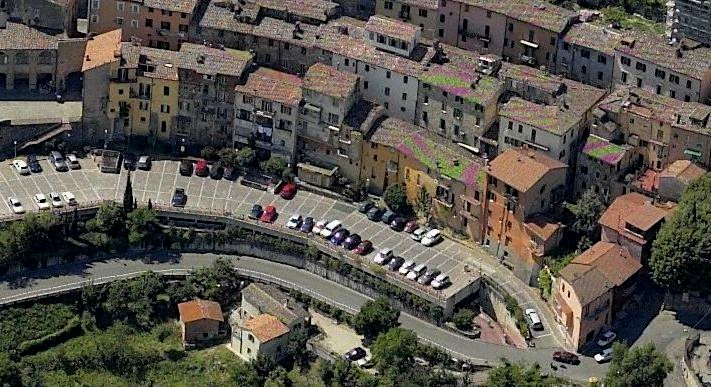
[Merediths window is seen on the top floor of the house in the lower foreground]
Welcome To Common Sense
This briefing was first posted with slightly different opening paras at the start of the annulled Hellmann appeal. New arrivals often tell us this helped them the most.
If you’ve come to this website because of the Amanda Knox book and interview, then welcome. Like all of us who come to this case, you have one key question: did they do it? The Knox book and interview seriously cherrypick the case, and perhaps haven’t helped you at all.
On the Internet, you will find people who are passionate in their defence of Amanda Knox and Raffaele Sollecito; and you will find people who are passionate in their support of an exceptionally talented girl who died, of a fine justice system previously untainted by PR, and of the prosecution’s very strong case.
Please click here for more
Monday, April 08, 2013
Experienced Trial Lawyer: There’s Far More Evidence Than UK/US Courts Need For Guilt
Posted by SomeAlibi
The false claim “there is no evidence”
Some amateur supporters of Knox and Sollecito have committed thousands of hours online to try and blur and obfuscate the facts of the case in front of the general public.
Their goal is simple: to create an overwhelming meme that there is “no evidence” against the accused, and thereby try to create a groundswell of support. Curt Knox and Edda Mellas and Ted Simon have all made this “no evidence” claim many times.
At least some some of the media have eagerly swallowed it.
The amateur PR flunkies make up myriad alternate versions of what created single points of evidence, often xenophobic scare stories designed to trigger emotional reactions, which they hope will be repeated often enough to become accepted as “the truth”.
And where things get really tricky, another time honored tactic is to go on at great length about irrelevant details, essentially to filibuster, in the hope that general observers will lose patience with trying to work it all out.
But time and again we have shown there is actually a great deal of evidence.
Evidence is the raw stuff of criminal cases. Let me speak here as a lawyer. Do you know how many evidence points are required to prove Guilt? One evidence point if it is definitive.
A definitive evidence point
If you’re new to this case or undecided, what is an easy example of ONE definitive evidence item that might stand alone? Might quickly, simply, and overwhelmingly convince you to invest more time into understanding the real evidence, not that distorted by the PR campaign?
In fact we have quite a choice. See the footprint which was second on that list.
Now see the table above. I recommend the use of this table of measurement to avoid the lengthy back and forward of narrative argument which so lends itself to obscuring the truth. I would like to present you with this single table of measurements to give you pause to question whether this line that there is “no evidence” is really true or whether it might be a crafted deception.
I present here a summarized view of critical evidence which suggests with devastating clarity that Raffaele Sollecito was present the night of the murder of Meredith Kercher. No lengthy text, no alternate versions, just measurements.
This FIRMLY places Sollecito in the very room where Meredith was attacked and killed.
In the small bathroom right next to Meredith’s bedroom was a bathmat. On it was found a bloody naked right footprint of someone walking straight towards the shower in the bathroom. The blood is that of Meredith.
The footprint is not Amanda Knox’s - it is too big - but we can compare it to the prints taken of Rudy Guede and Raffaele Sollecito.
In Judge Massei’s report the multiple measurements were detailed in the narrative over many sentences and, in that form, their immediate cumulative impact is less obvious. It is only by tabulating them, that we are forcefully hit by not one but two clear impressions:
The measurements are extremely highly correlated to the right foot of Raffaele Sollecito in twelve separate individual measurements. In themselves they would be enough for a verdict of guilt in all but a few court cases.
But they also show a manifest LACK of correlation to the right foot of Rudy Guede, the only other male in that cottage on the night. Have a look for yourself.
If you were the prosecution, or indeed the jury, and you saw these measurements of Raffaele’s foot versus the print, what would you think? Answer the question for yourself based on the evidence admitted to court.
Then, if you compare further, exactly how plausible do you find it that the measurements of the bloody imprint are Rudy Guede’s instead?
Not only are some of the individual measurements of Rudy’s imprint as much as 30% too small, but the relative proportions of length and breadth measurements are entirely wrong as well, both undershooting and overshooting by a large margin (70% to 150%).
Conclusions that must follow
Presented with those numbers, would you consider those measurements of Rudy Guede’s right foot to show any credible correlation to those of the footprint on the mat?
Supporters of the two have tried frantically to create smoke screen around this - the wrong technique was used they say (ruled not so by the court) / they are the wrong measurements (all 32 of them? that Raffaele’s are matching exactly or within a millimetre but Rudy’s are out by as much as -30% to +50%...?).
The severity of the impact on the defence is such that there was even a distorted photoshopped version circulated by online supporters of Raffaele and Amanda until they were caught out early on in coverage. But it is hopeless, because these are pure measurement taken against a scale that was presented in court and the data sits before you.
Have a look at the measurements and understand this was evidence presented in court. Whose foot do you think was in that bathroom that night? Rudy Guede? Or was it Raffaele Sollecito on twelve counts of measurement?
And if you find for the latter, you must consider very seriously what that tells you both about the idea there is “no evidence” in this case and who was in the cottage that night…
Monday, April 01, 2013
Alarm Bells Ignored: Overconfident PR And Lawyers May Have Led To That Shock At Cassation Outcome
Posted by Our Main Posters
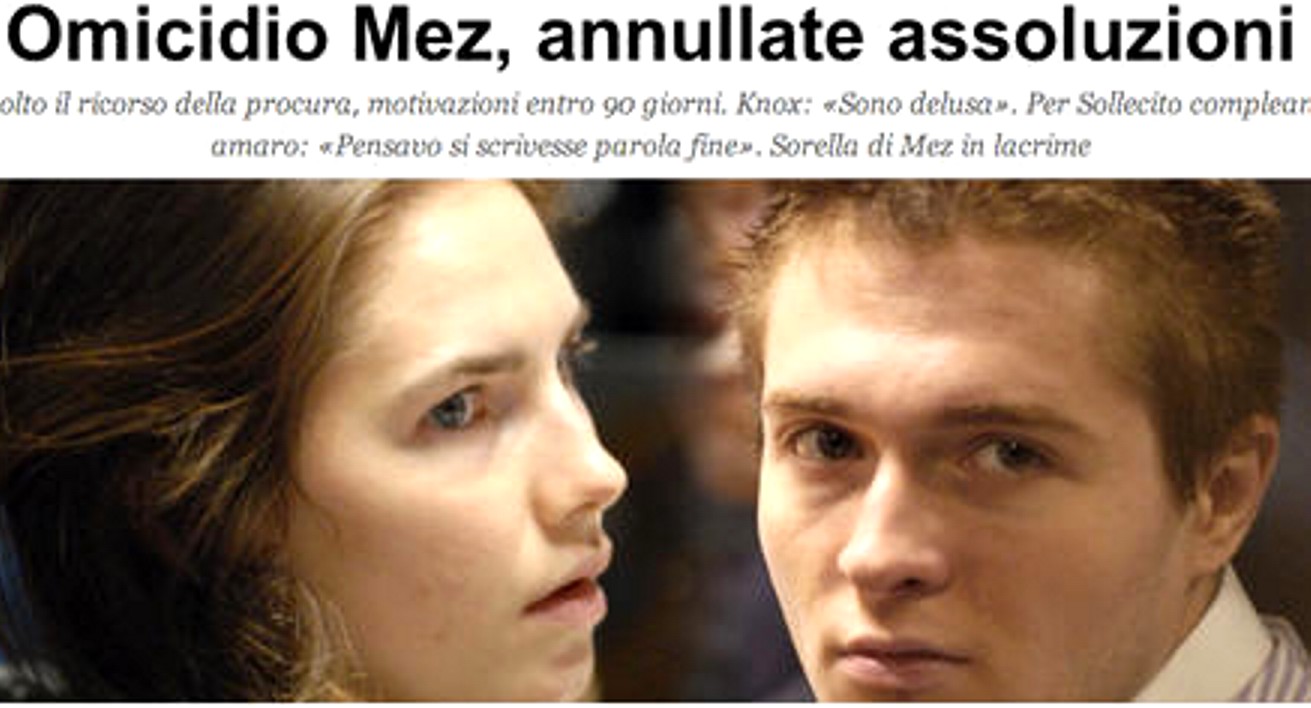
Amanda Knox has seemed to us more stunned than confident since she got out of Capanne. Her father mentioned that she was not given the whole picture there.
But we have been surprised in recent weeks at how the defense lawyers and spokesmen and especially Raffaele Sollecito and Giulia Bongoirno and Carlo Dalla Vedova and the PR flunkies were seemingly seeing the Supreme Court appeal as a forgone conclusion in their favor, a blip requiring no change in the end game.
Here are 20 warning bells that we think they might have missed or heard wrongly which contributed to a shocked and ill-prepared reaction to the Cassation ruling, and each of which a team of hard-nosed lawyers not befuddled by PR might have heard and responded to quite differently.
- 1. The Italian media in 2007-2008 in fact did not blow the case and Knox herself out of all proportion. Most of the lurid headlines appeared in the UK press where they had zero effect on the 2009 jury. There really was a hard case to answer.
2. The British and American media mostly came to be manipulated on the lines Barbie Nadeau’s book described, which meant a big contrast opened up between hard Italian reporting and fantastical UK and US reporting.
3. The Knox and Sollecito teams shrugged off a short-form trial in October 2008 at which point they might have pleaded that Meredith’s murder was not intended and drugs and mental quirks had resulted in a terrible but unintended outcome, perhaps providing relief both for themselves and Meredith’s family.
4. The prosecution part of the trial in 2009 was in fact, contrary to frequent illusory claims, fast and comprehensive and decisive, and it may have been at the end of that phase that the jury was already ready to vote guilty.
5. The defense part of the trial was far less successful with Amanda Knox on the stand suggesting to Italians that she was cold-blooded and uncaring, and from then on the defenses were desultory and dispirited with no strong points ever landed. Several days one or other of them failed to show.
6. The prosecution summation at end of trial was extremely powerful and included in it was a very convincing 15-minute crime-scene recreation video (never released to the public) which accounted for all the marks and stains in Meredith’s room and on her body by an attack group of three.
7. The Massei report, again contrary to frequent illusory claims later, was considered by those familiar with such reports a model of good logic and reasonable assumptions. It laid out and connected hundreds of evidence points which in a normal appeal process would have been unassailable.
8. The 2011 appeal did not happen because Massei was riddled with legal errors and wrong assumptions, which would have been the criteria for any British or American judge to agree to such an appeal. It happened solely because, unique to Italy, such appeals are automatic if demanded, resulting in a huge number of appeals on weak grounds.
9. Italy does not have a terrible record of trial reversals as some claim. It has a record of fine-tuning and adjustments of thousands of appeals by appeal juries seemingly wishing to prove that they are being diligent. Cassation is aware of this quirky systemic effect, and it often bounces back appeal outcomes to dead center.
10. It had appeared that the PR effort was joined by a lot of influential “heavies” including MP Girlanda, Judge Heavey, Senator Cantwell, Joel Simon of CPJ, and the billionaire Donald Trump. Most had limited positive effect in the US and less in Italy, and have been quiet since the Cassation ruling.
11. Judge Hellmann was a surprise replacement for Judge Chiari, then the able and experienced head of the criminal division. (He resigned over this.) Judge Hellmann, a good civil judge, had very limited criminal-case experience. Chief Judge De Nunzio has not explained why he replaced Chiari .
12. The scope of appeals is carefully laid out in the Italian judicial code, and they are not to be repeat trials with overall reconsideration of all evidence and al witnesses only absent the careful presentation process and cross-examination at trial. In the US or UK the defense grounds for appeal might simply have been rejected.
13. Prosecutor Mignini was provisionally convicted in March 2011 of abuse of office, but careful examination would have revealed that the grounds were spurious and he had no need of a conviction in this case. Cassation in the past month has killed his own case terminally and chastized those who brought it.
14. Incriminating DNA was found in Meredith’s room and also outside it in many locations, and also on a knife in Sollecito’s apartment. DNA consultants were “illegally” appointed who muddied the waters but decisively disproved none of it.
15. The Supreme Court is on record as deciding that three perpetrators attacked Meredith. The defenses never set out to prove Guede was a lone wolf attacker, for a long list of reasons, and they failed to prove that jailhouse witnesses Alessi and Aviello had pointed out credible alternatives.
16. The Hellmann-Zanetti report surprised a majority of Italian lawyers who read it for its passion and broad scope and tendentious logic, and for misunderstanding certain key legal concepts. Some instantly saw it as having feet of clay, and a pretty sure candidate for reversal.
17. The significance of Chief Prosecutor Dr Galati in the process seemed seriously discounted. UK and US media mostly ignored his appointment and where he came from, which was in fact Cassation in Rome where he was a highly effective Deputy Chief Prosecutor.
18. The Galati appeal itself was extremely competent and hard line and targeted the Hellmann appeal outcome in several levels or layers in a total of ten points. It is one of the toughest and most sweeping appeals ever filed in Italy, and in the US or UK alarm bells really would have gone off at this one.
19. Sollecito’s book was seemingly okayed by his lawyers, although it causes them major complications in three respects: it introduces new “facts” which contradict his own defense; it derides Italian officials and accuses them of crimes; and it looks like a seedy attempt to make money out of a crime for which the writer is still on trial.
20. While Sollecito had been acting happily oblivious and super-confident in recent months, he has added to Amanda Knox’s own problems by semi selling her out in his book, and by waking the new 800 pound gorilla of contempt of court prosecutions for not respecting the judicial process.
It may not surprise you to learn that Giulia Bongiorno has not had a very winning record at Cassation, and as far as we know the other lawyers have no experience of winning there at all.
Monday, February 18, 2013
Raffaele Sollecito Now Under Formal Investigation For New Crimes Apparently Unprecedented
Posted by Our Main Posters
Breaking news. The Chief Prosecutor for Tuscany Dr Quattrocchi (above and below) has taken this investigation of Sollecito behind the scenes. Dr Quattrocchi is actually under no compulsion to make any of the Perugia and Rome complaints public before his investigation is complete. He has ordered all documents removed from the public domain. This is specifically to give the defense and their PR no advantage, and to make sure those others in Perugia who are going to complain about being defamed do so without harm.
Overview
This is a contempt of court case as court officials have been impugned. This is Wikipedia’s definition of “contempt of court” under US and UK common law.
Contempt of court is a court order which in the context of a court trial or hearing, declares a person or organization to have disobeyed or been disrespectful of the court’s authority.
Often referred to simply as “contempt,” such as a person “held in contempt,” it is the judge’s strongest power to impose sanctions for acts which disrupt the court’s normal process.
A finding of contempt of court may result from a failure to obey a lawful order of a court, showing disrespect for the judge, disruption of the proceedings through poor behaviour, or publication of material deemed likely to jeopardize a fair trial.
A judge may impose sanctions such as a fine or jail for someone found guilty of contempt of court.
We may now find out much more about the equivalent under Italian law.
When Raffaele Sollecito and Amanda Knox were released at the end of 2011, the prosecution filed a Supreme Court appeal within the allotted period. This automatically meant that Sollecito and Knox still stood accused of crimes until the Supreme Court finally signs off.
Typically Italian defendants in such a legal status get good legal advice, on the lines of “Shut up and keep your heads down. We need to be the only ones doing the talking here.”
Here such advice may or may not have been forthcoming, but the public record strongly suggests it was not. In fact Sollecios entire legal team is credited by both himelf and his shadow writer Andrew Gumbel with helping. This is what Gumbel wrote in his Acknowledgments:
Donatella Donati in Luca Maori’s office gave up many hours to make the official documentation available and to present it all in a cogent order. She’s a largely unsung hero in this story and deserves recognition for her extraordinary efforts on Raffaele’s behalf. Giulia Bongiorno, Luca Maori, and Tiziano Tedeschi answered questions and made comments on parts of the manuscript.
In the same Acknowledgments Sollecito credits the following.
I was lucky to have a crack legal team who showed their devotion to the truth and, in some cases, did not even request payment. The team of lawyers and consultants included Adriano Tagliabracci, Francesco Vinci, Bruno Pellero, Francesco Introna, Giulia Bongiorno, Maurizio Parisi, Daniela Rocchi, Luca Maori, Donatella Donati, Marco Brusco, Aldo Poggioni, Delfo Berretti, Tiziano Tedeschi, and Antonio D’Ambrosio.
Interestingly, Luca Maori has already left Sollecio’s legal team, and all eyes are now on Giulia Bongiorno. Buy plenty of popcorn. Lawsuits could fly between lawyers and family.
Since the end of 2011 Curt Knox’s forces seem to have have gone full steam ahead with their own vilifications of the Italian prosecutors, police, judges, and witnesses - in fact almost anyone who had any role in 2009 in finding them guilty, or came to believe that was a fair finding. Ourselves included.
In late 2012 Curt Knox apparently invited all the most fervent of these attackers to Seattle, including Frank Sforza and Bruce Fischer, as some sort of reward for their legally very ill-advised campaign. Buy plenty more popcorn. Lawsuits could fly here as well.
Raffele Sollecito’s forces in Italy had been a lot more restrained.
But at a stroke, the shrillness of Raffaele Sollecito leapfrogged that of Amanda Knox’s forces, with the publication of his book Honor Bound by Simon and Schuster in English in the UK and US last September,
INSTANTLY the book became notorious in Italy, because excerpts were read out by an Italian reporter in New York on the national television show Porta a Porta. Raffele Sollecito’s father Francesco was on that show, and he was increasingly forced to admit a key claim in the book was invented. It simply never happened. His son made it up.
The false claim by his son that Francesco was made to repudiate - it reappears over many pages - concerned a claimed deal engineered by his family and offered by the prosecution to Sollecito.
The deal he claimed was to roll over on Amanda Knox, and if Sollecito did so, he would be home free.
Following the Porta a Porta show, the book (obtainable on UK Amazon, where many false claims are repeated in the reviews) began to make its rounds in Italy. It took some time before many official parties accused of crimes by Sollecito obtained copies and started to explore their own legal possibilities. They are apparently still far from finished.
At the end of last week, the Chief Prosecutor for Tuscany Giuseppe Quattrocchi received the first official request from Perugia, which is to investigate 12 very serious claims in the book against the prosecution and the legal institutions of Italy. The complaint nominates a number of witnesses.
The Prosecution office of Florence now has a maximum of six months to investigate whether there is a case against Sollecito and other named parties. If so, they will steer it through the hoops of the Italian process.
The potential ripple effects of this appear to us to stretch on and on. They could come to engulf both legal teams (credited in the book with helping) and all of the PR for both defendants. Sollecito’s publisher and shadow writer are specifically named in the complaint
If Amanda Knox is not let off the hook by the Italian Supreme Court late in March (the outcome we consider most likely, given the great strength of the appeal) the smart way for Knox to go in light of this could be to junk all her websites, her book, and her interviews, and throw her supporters under the bus. Plus maybe get smarter lawyers - the aggressive and inexperienced Dalla Vedova does her no favors.
Keeping Amanda Knox’s head out of this deadly new line of fire may be very late - but maybe better late than never.
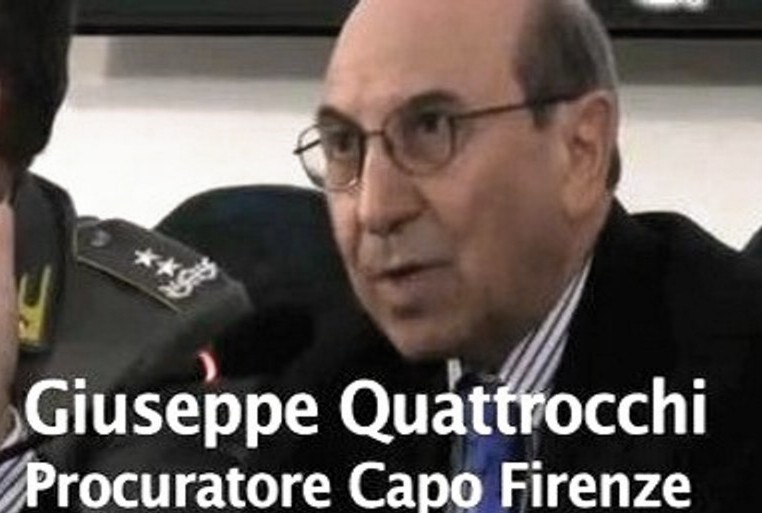
Wednesday, December 12, 2012
Simon & Schuster Seem To Be Seriously Rattled Over Lack Of Due Diligence On Sollecito’s Book
Posted by Peter Quennell
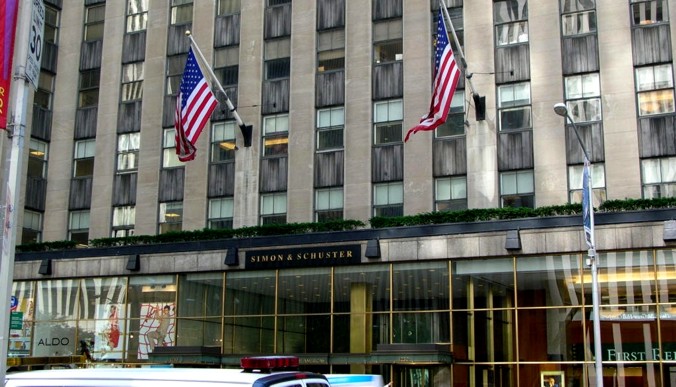
See this emailed exchange which took place late today.
What Simon & Schuster’s agent is complaining about was a chronological reordering (behind the scenes and not linked to from the front page) of these many corrections here. Our Kindle and hardcover copies were legally purchased. Simon & Schuster put about 1/4 of the book on the front of their own website, and Google Books also carries about 1/4 of the book to read free.
Admittedly, our corrections may have been quite a shock. However, we didnt cause the book sales to tank. All of our past posts on Raffaele Sollecito’s book can be seen here.
*******
Mr Eraj Siddiqui
119 South B Street Suite A,
San Mateo, CA 94401
Dear Mr Siddiqui
Thank you for your “Verified DMCA Removal Request from Attributor” copied below.
The book you refer to appears to contain up to 30 instances of criminal defamation under Italian law and literally hundreds of wrong and injurious statements that are hurtful to many fine officials in Italy.
We have full legal rights to point out the myriad mistakes in the book. In fact a defamation of a prosecutor in the book has ALREADY been admitted on Italian national TV by the writer’s own father in Rome.
That Simon & Schuster apparently failed to do their legal and factual due diligence on the book prior to publishing seems to us to be absolutely nobody’s fault but their own. They are hardly new at this game.
Nice try, but sorry, no cigar.
Peter Quennell
*******
Dear Sir/Madam,
I certify under penalty of perjury, that I am an agent authorized to act on behalf of the Rights Holder identified below, the owner of certain intellectual property rights in the Work(s) identified below.
I have a good faith belief that the information contained in this notice is accurate, and that the page or material listed below is not authorized by the Rights Owner, its agents, or the law for use by the individual(s) associated with the identified page listed below or their agents.
To the extent that the Digital Millennium Copyright Act, the European Union’s Directive on the Harmonisation of Certain Aspects of Copyright and Related Rights in the Information Society (2001/29/EC), and/or other laws and regulations relevant in European Union member states or other jurisdictions apply to your service, if at all, I HEREBY DEMAND THAT YOU ACT EXPEDITIOUSLY TO REMOVE OR DISABLE ACCESS TO THE PAGE(S) OR MATERIAL(S) at the Infringing URL(s) identified below.
Note that in some cases the pages/material may have been removed after the sending of this notice but prior to your review.
My contact information is as follows:
Organization name: Attributor Corporation as agent for Simon & Schuster Inc.
Email: .(JavaScript must be enabled to view this email address)
Phone: 650.306.9474
Mailing address:
119 South B Street
Suite A,
San Mateo, CA 94401
Nothing contained in this letter or in any attachments constitutes a waiver or relinquishment of any right or remedy possessed by the Rights Holder, or any affiliated party, all of which are expressly reserved.
My electronic signature follows:
Sincerely,
/Eraj Siddiqui/
Eraj Siddiqui
Attributor, Inc.
*** INFRINGING PAGE OR MATERIAL ***
Infringing page/material that I demand be disabled or removed in consideration of the above:
Rights Holder: Simon & Schuster
Original Work: Honor Bound
Infringing URL: https://truejustice.org/ee/index.php?/tjmksollecitosbook/P0/
Infringing URL: https://truejustice.org/ee/index.php?/tjmksollecitosbook/P5/
Infringing URL: https://truejustice.org/ee/index.php?/tjmksollecitosbook/P10/

